|

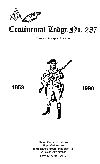
Welcome
to Continental Lodge #287's Home Page. We Fraternally invite you to
view our Communication and visit us on our regular meeting night. We
meet on the first Wednesday of the month at Grand Lodge, 71 West 23rd
Street in the Renaissance Room on the 6th Floor at 7:30PM. Our
Brothers meet for dinner prior to the meetings. Check the
Communication for location and feel free to join us..... Dutch of
course!!
Be Well, God Bless and let our Brotherly Love Spread Around the
World!!!
 |
|

 |
Sign Our GuestBook
View Our GuestBook |
| If you are not already a member
of our ancient & honorable fraternity, and would like additional
information, please contact this Lodg or any of our fraternity.
Although we cannot directly solicit members, we will be pleased to
respond to your interest by answering your questions and will gladly
provide a petition at your request. |
|


| |
 Home Home
| Enrico
Wallenda
THE FLYING WALLENDAS: LEGENDS OF THE HIGH WIRE, the most celebrated high-wire family of
the 20th century. The troupe is known both for their incredible daring and for the
gruesome tragedies that took so many of their lives. The family's patriarch, Karl
Wallenda, and his family soared hundreds of feet above the ground, courting death and
often succumbing to it. The daring high-wire artists dazzled crowds in America and Europe
from the 1910s until 1978, when Karl fell to his death from 120 feet above a Puerto Rico
street. Karl's death was the seventh fatal Wallenda high-wire death of the century and
effectively ended their reign as the first family of the high wire. Return
to Last Page |
| Jack
Warner
The Warner Brothers studio was founded by the four Warner brothers in 1923.
Harry (1881-1958), Albert (1884-1967), Sam (1888-1927), and Jack (Jacob) Warner
(1892-1978) were members of a Yiddish-speaking Jewish family from Krasnashiltz, Poland
(then in czarist Russia). Their father, a cobbler named Benjamin Warner (probably Varna),
had married Pearl Leah Eichelbaum in 1876. They had three children, one of whom died at
age four. Desiring a better future for his family and himself, in 1883 Benjamin made his
way to Hamburg, Germany and then took a ship to America. The two surviving children,
Hirsch (later Harry) and Anna, and wife Pearl joined him in Baltimore less than a year
later. The rest of the Warner brothers (and two sisters) were born in the U.S. except for
Jacob (later Jack), who was born in London, Ontario, Canada in 1892.
The brothers learned to work together for family survival. They were living in
Youngstown, Ohio when Harry decided to hock the family's beloved delivery horse to buy a
used Edison Kinetoscope projector. It was the year 1904 and the beginning of the Warner
brothers' venture into the movie business. At first the brothers used the Kinetoscope for
a traveling movie show in small towns in Ohio and Pennsylvania, but soon set up a
permanent nickelodeon in Newcastle, Pennsylvania. The brothers' modest hole-in-the-wall
cinema with the imposing name "Cascade Theater" opened in May 1905 with seats
borrowed from a neighboring funeral parlor.
The difficulties of obtaining good films at a good price drove the brothers into the
film distribution business. They discovered the real money was in distribution rather than
exhibition. They sold the Cascade Theater for $40,000 and jumped into film distribution
full time -- until they ran into the Edison Trust (Patents Company) which cut off films to
distributors who did not pay a royalty. By 1912 the brothers were out of the distribution
business, but almost forced into the film production business. "Warner Features"
set up a studio in an old St. Louis steel foundry, but the two low-budget films produced
there were unmarketable. Two of the brothers headed west to California to start a new film
exchange. Before long the Warner Brothers studio was also producing films. Return
to Last Page |
| Darryl
Zanuck
Darryl Zanuck was born in Wahoo, Nebraska in 1902. In spite of his
extreme youth, he joined the Army and head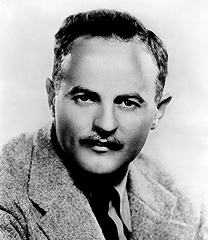 ed to
France to fight in World War I. After the war, he began to write, edit, and finally
produce for Warner Bros. Pictures, Inc.. He was made chief executive in charge of
production in 1931. ed to
France to fight in World War I. After the war, he began to write, edit, and finally
produce for Warner Bros. Pictures, Inc.. He was made chief executive in charge of
production in 1931.
In 1933, with Joseph M. Schenck, he organized Twentieth Century
Pictures, which two years later merged with Fox as the Twentieth Century-Fox Film
Corporation with Zanuck as vice president in charge of production.
Zanuck served in the Army again early in World War II, making
training and documentary films, and in 1943 returned to his company. In 1956 he became an
independent producer, releasing his films through Twentieth Century-Fox, and in 1962 he
was elected president of the company.
Recognized as one of Hollywood's most brilliant producers, he
developed many new star performers and pioneered in the use of CinemaScope. Return
to Last Page |
| William
Wyler
Wyler's body of work has allured critics for years. The German-born director came to
America as a young man,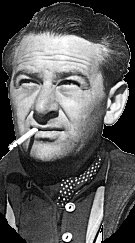 taking menial jobs in the movie industry
until making his directorial debut with "Crook Busters" at the age of 23.
Wyler's earliest films were short, silent westerns such as "Hell's Heroes,"
screening at Melnitz on May 14. He abandoned this genre, however, and moved on to the more
dramatic works that would come to define him, and to earn him and his actors a slew of
Academy Awards. taking menial jobs in the movie industry
until making his directorial debut with "Crook Busters" at the age of 23.
Wyler's earliest films were short, silent westerns such as "Hell's Heroes,"
screening at Melnitz on May 14. He abandoned this genre, however, and moved on to the more
dramatic works that would come to define him, and to earn him and his actors a slew of
Academy Awards.
Despite this success, film critics found it impossible to pin down Wyler's style. He was
one of the first American filmmakers to be influenced by Italian neo-realism, and some of
his innovative techniques (like deep focus photography) were credited to other directors
such as Orson Welles. After years of being underestimated, Wyler is finally receiving the
attention he deserves.
"He was seen as a director without a style," says Pendleton. "That's why he
never became an icon for the critics in this country the way Ford or Hitchcock did. Part
of the reason that Wyler's being rediscovered now is because that criticism is being
revisited. And because Hollywood history is being revisited."
Much of this history was controlled by the Hollywood studio system of the '30s and '40s.
Alsberg explains that this system held directors like Wyler under contracts, handing them
assignments and then distributing the products. This assembly line movie-making left
little creative freedom for directors like Wyler, and Alsberg says that "a lot of
filmmakers just rolled out film after film that just didn't mean anything."
In many ways, Wyler escaped the unimaginative, generic trap of the studio system. His
films convey larger meanings and experiences the hardships of returning home after war
("The Best Years of Our Lives"), the experiences of a Jewish American man in the
1930s ("Counselor at Law") as well as some comic, lighthearted pieces such as
1935's "The Good Fairy."
Alsberg and Pendleton decided to honor Wyler when the director's daughter called them from
the Berlin Film Festival in February. She needed prints of some of her father's films for
the Festival's program, and she suggested that UCLA also show a retrospective of his work.
Alsberg and Pendleton were intrigued, and they began the long process of creating
"The Perfection of William Wyler."
Pendleton believes that this process involved both research and direction.
"We just try to get a sense of the person and the career," he explains,
"and choose films that will reflect whatever it is you're trying to say about that
career. We wanted to honor what everybody's image of Wyler is, but also throw in a few
angles."
These angles highlight the director's range, and Alsberg hopes they will also capture the
public's attention.
"We are constantly re-educating ourselves in terms of films and in terms of
society," says Alsberg, but she and Pendleton feel that many students are missing out
on this part of education. Even though few students know of Wyler or his films, his place
in cinematic history could be changed by their attention to his work.
This program uncovers Wyler from the old facade of the studio system, and presents his
films to modern audiences so that Wyler, rather than his movies, can be honored. Alsberg
just hopes that students will take advantage of the opportunity.
"It's a constant battle for us," she says, "to encourage students to
broaden their horizons and not just go see the latest film in Westwood, and to come here
and see films that they may not ever see again." Return
to Last Page |
| Egbert
Austin "Bert Williams"
Bert Williams was the Jackie Robinson of the American theater. He broke the color
barrier in both Vaudeville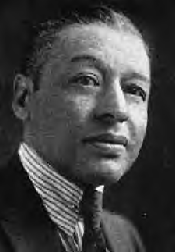 and Broadway. and Broadway.
He is virtually unknown today. But in his time, Bert Williams was considered one of the
world's finest comedians. His musical recordings (some mastered on wax cylinders, the
state of the art in his heyday) were among the best selling hits of the era.
Bert Williams lived and worked in a time of primitive racism. He began his career with
Minstrel Shows (and Minstrel Shows were big time show business before radio, movies, and
television), where the theatrical convention was to wear Blackface and to portray the
"shiftless darky". Through the eyes of the era this was not recognized as the
arrogantly racist action that it is; but was simply seen as another ethnic comic type,
like the drunken Irishman, the cheap Scotsman, the Coniving Jew, and a number of other
stock characters that comics performed in Saloons, Music Halls, Burlesque and Vaudeville
houses all over America. Bert continued to work in blackface the rest of his career,
because his producers and fans would accept nothing less. Return to Last Page |
| John Wayne
IT is a rare actor who can transcend mere movie-star status to
become an icon of American culture. John Wayne was such an actor, and very seldom, if
ever, has an entertainment figure branded as indelible of an impression on the collectiv e
consciousness as he did. Film critic Leonard Maltin encapsulated the Duke's enduring
impact when he said, "[Wayne] has come to represent the archetypal American of our
country's formative period: honest, direct, decisive, solitary, and reverent; one whose
faith in his own ability enables him to take action when it's needed, and whose belief in
justice spurs him to right wrongs when they're discovered." His legend remains a
difficult one to demystify, some two decades after his death--so looming was the shadow
the Wayne persona cast on the cultural landscape, that most people still can't separate
the real Wayne--the man and actor--from his iconic screen presence. e
consciousness as he did. Film critic Leonard Maltin encapsulated the Duke's enduring
impact when he said, "[Wayne] has come to represent the archetypal American of our
country's formative period: honest, direct, decisive, solitary, and reverent; one whose
faith in his own ability enables him to take action when it's needed, and whose belief in
justice spurs him to right wrongs when they're discovered." His legend remains a
difficult one to demystify, some two decades after his death--so looming was the shadow
the Wayne persona cast on the cultural landscape, that most people still can't separate
the real Wayne--the man and actor--from his iconic screen presence.
Marion Michael Morrison was attending the University of Southern
California on a football scholarship, when he stumbled into acting by virtue of his summer
job as a laborer at Fox. On the studio lot, he met and befriended director-on-the-rise
John Ford, in whose films he would occasionally pop up as an extra. Ever a commanding
physical presence, Marion, billed as Duke Morrison, was eventually entrusted with several
larger, but still largely insignificant, assignments in some of Ford’s late twenties
films. In 1930, the director recommended him for the lead role in Raoul Walsh’s epic,
The Big Trail. The lackluster reception that greeted the film certainly didn’t
lead the newly baptized John Wayne to stardom; in fact, the newcomer was dropped by the
studio not long after the picture tanked at the box office. What The Big Trail
established, however, was Wayne's ability to carry a film, and he subsequently slogged
through roles in countless low-budget oaters and occasional bit parts in A-grade movies of
the thirties. One of his more prominent assignments during this period of little
advancement was his role as Stony Burke in eight installments of Republic's tireless
"Three Mesquiteers" series. Tireless was just the word to describe Wayne, who
had been busting his hump as an unappreciated contract player for nigh on a decade by
then; tireless would continue to be an applicable adjective throughout his amazingly
prolific career as an actor, director, and producer.
In 1939, Ford came through once again for his young actor friend,
when he cast him as the Ringo Kid in Stagecoach, a film which is now acknowledged
by many to be the director's greatest frontier epic. The modestly-budgeted effort
overshadowed all Westerns that had come before, not to mention greatly influenced those
that followed; as for Wayne, his Oscar-caliber performance in the film yielded what seemed
like overnight star status. The Duke would go on to turn in some of his finest
performances in front of Ford’s camera, in such classic films as They Were
Expendable (1945), Fort Apache (1948), Rio Grande (1950), The Quiet
Man (1952), The Searchers (1956), and The Man Who Shot Liberty Valance
(1962). As Wayne's nascent legend took shape and his box-office drawing power grew apace
in the wake of his Stagecoach breakthrough, he discovered another popular and
bankable outlet for his overtly manly screen persona: portraying hard-bitten, yet
compassionate, soldiers. That John Wayne was a he-man of the first order was more than
confirmed by his larger-than-life characterizations in actioners like Flying Tigers
(1942), Back to Bataan (1945), and Sands of Iwo Jima (1949), the latter of
which netted him his first Academy Award nomination. This man-in-wartime specialty was
slightly ironic in that Wayne had been excused from active duty due to a common ear
infection that he developed while filming underwater sequences for 1942's Reap the Wild
Wind.
As the forties drew to a close, there was no doubt that Wayne had
become a star of staggering popularity, but he finally proved himself to actually be a
fine actor, and thus worthy of all the puffery, by turning in more subtly nuanced
performances in such late-decade films as Howard Hawks's Red River (1948, as an
uncompromising cattle baron) and Ford's She Wore a Yellow Ribbon (1949, as a
mustachioed, due-for-retirement calvary captain). Wayne cemented his growing cinematic
supremacy by establishing his own film production company, Wayne-Fellowes (later renamed
Batjac), in association with his sons Michael and Patrick; the company had a tremendously
successful track record, boasting such signature Wayne vehicles as Angel and the Badman
(1947), Island in the Sky (1947), Hondo (1953), and The High and the
Mighty (1954). Not that the fifties and sixties didn't deliver a fair share of
mediocre outings to outright missteps: when directors relied on the Duke persona to sell
their lackluster projects, or when Wayne strained in ridiculous directions to prove
himself capable of playing more than just the standard-issue calvaryman or soldier, the
results were often unsatisfactory, if predictably lucrative (witness Wayne in the role of
Mongol vanquisher Genghis Khan in 1956's The Conqueror, for proof of the latter).
And yet, during this era of easy coasting, Wayne delivered possibly the finest performance
of his career, in Ford's remarkable 1956 Western The Searchers--his mysterious and
obsessive Ethan Edwards stands as one of the most compelling and troubling
characterizations in the history of American cinema.
Wayne was himself a compelling and troubling figure: his status as
an American hero grew ever greater, and ever more contested, with the passing years.
Despite the fact that his soap-boxing for various conservative causes left liberals
pouting into their popcorn, his films continued to please audiences, if not critics, up
through the Vietnam era (Wayne was particularly outspoken in--and lambasted for--his
support of U.S. involvement in the conflict). Amid all the knotty contention surrounding
his politics, Wayne trundled home with a Best Actor Oscar for his performance as the
boozy, irascible Marshal Rooster Cogburn in the 1969 Western True Grit (he would
reprise the classic characterization in the 1975 sequel, Rooster Cogburn). Despite
the declining popularity of the Western, Wayne turned in an exceptional and elegiac
performance as a gunslinger dying of cancer who comes to terms with his life and legend in
Don Siegel's The Shootist (1976). It was to be a poignantly self-reflective swan
song performance for the actor, whose own death from cancer three years later left a
nation bereft--all politics aside. Return
to Last Page |
Red
Skelton
The son of a former circus clown turned grocer and a cleaning woman, Red Skelton was
introduced to showbiz at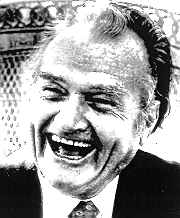 the age of seven by Ed Wynn, at a vaudeville
show in Vincennes. At 10, he left home to travel with a medicine show through the Midwest,
and joined the vaudeville circuit at 15. At 17 he married Edna Marie Stilwell, an usher
who became his vaudeville partner and later his chief writer and manager. He debuted on
Broadway and radio in 1937 and on film in 1938. His ex-wife/manager negotiated a
seven-year Hollywood contract for him in 1951, the same year "Red Skelton Show,
The" (1951) premiered on NBC. For two decades, until 1971, his show consistently
stayed in the top twenty, both on NBC and CBS. His numerous characters, including Clem
Kaddiddlehopper, George Appleby, and the seagulls Gertrude and Heathcliffe delighted
audiences for decades. First and foremost, he considered himself a clown, although not the
greatest, and his paintings of clowns brought in a fortune after he left television. His
home life wasn't completely happy--two divorces and a son Richard who died of leukemia at
age nine--and he didn't hang around with other comedians. He continued performing live
until his recent illness, and he was a longtime supporter of children's charities. Return
to Last Page the age of seven by Ed Wynn, at a vaudeville
show in Vincennes. At 10, he left home to travel with a medicine show through the Midwest,
and joined the vaudeville circuit at 15. At 17 he married Edna Marie Stilwell, an usher
who became his vaudeville partner and later his chief writer and manager. He debuted on
Broadway and radio in 1937 and on film in 1938. His ex-wife/manager negotiated a
seven-year Hollywood contract for him in 1951, the same year "Red Skelton Show,
The" (1951) premiered on NBC. For two decades, until 1971, his show consistently
stayed in the top twenty, both on NBC and CBS. His numerous characters, including Clem
Kaddiddlehopper, George Appleby, and the seagulls Gertrude and Heathcliffe delighted
audiences for decades. First and foremost, he considered himself a clown, although not the
greatest, and his paintings of clowns brought in a fortune after he left television. His
home life wasn't completely happy--two divorces and a son Richard who died of leukemia at
age nine--and he didn't hang around with other comedians. He continued performing live
until his recent illness, and he was a longtime supporter of children's charities. Return
to Last Page |
| Peter
Sellers
Peter Sellers was born in North London, on September 8,
1925. He made his first stage appearance at age two weeks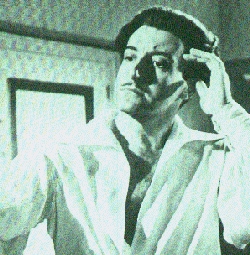 during one of his parants' music hall shows.
during one of his parants' music hall shows.
While impersonating two popular BBC stars, he reccomended himself to a BBC producer. The
producer actually thought that the "men" talking were in fact the real BBC
stars, but once he had realized that he had been fooled, he gladly gave Sellers a place on
the air.
He starred in "Crazy People" the radio show, which made it's debute on May 28,
1951. The name changed to the "Goon Show" on June 22, 1952. This exposure opened
new doors to his future. The "Goon Show" ran until January 28, 1960.
His first film was "Penny Points to Paradise" (1951) His first American film was
"The Mouse that Roared." In this movie he played multiple characters. (like
Eddie Murphy does in The Nutty Professor) "Dr. StrangeLove" won him his first
Oscar nomination. In 1963, "The Pink Panther" was released. Sellers got his
second Oscar for "Being There" in which he played a Chance, a child like
gardener mistaken for an economic guru. His last film was "Fu Manchu" (1980).
Sellers died on July 24, 1980. They played "In the Mood" at his funeral.
Everyone there had to hold back the laughing for Sellers' had always hated that song. But
that is probably how he would have wanted it. He had made people of all ages laugh while
he was living, and he will forever continue to do that, even while he's gone Return
to Last Page |
| Florenz
Ziegfeld
Florenz Ziefield was perhaps America's all-time greatest showman. His Ziefield Follies
were all the rage with audiences in the early part of this century. He made household
names out of stars like W.C Fields, Will Rogers, and Fannie Brice. Biography presents the
spectacular story of Florenz Ziegfeld. Starting out by running his family's business, the
Chicago Musical College, Ziegfeld capitalized on the public's appetite for high-brow art
mixed with low-brow entertainment by hiring a strong man to perform at his music hall. It
was a stroke of genius, and a gimmick he would return to with tremendos success over the
next 35 years. Ziegfeld's unique understanding of the public's taste for entertainment
made him a show-biz legend. 1995
He grew up in Chicago and managed vaudeville tours in Europe and the Far West before
marrying the French actress Anna Held, for whom he produced seven musicals, including Papa's
Wife (1899) and Miss Innocence (1908). When in New York during the 1890's, he
usually stayed at the Netherland Hotel (781 Fifth Avenue); after 1900 he had a permanent
suite in the Ansonia Hotel (2107 Broadway).
He was best known for producing revues designed to "glorify the American
girl," including twenty-one Follies (1907-25, 1927, 1931), The Century Girl
(1916), and Miss (1917) at the Century Theatre, and Midnight Frolics
(1915-22), which was presented at late-night dinner theaters. He also produced a number of
musical comedies in which Eddie Cantor and Marilyn Miller played the leading roles, among
them Sally (1920), Whoopee (1928), and Show Boat (1927).
Ziegfeld eventually moved to Hollywood to advise Samuel Goldwyn on motion pictures
based on the Follies.
Return
to Last Page |
| David
Sarnoff
David Sarnoff was born to Abraham and Leah Sarnoff on February 27, 1891. His father was
a Jewish painter in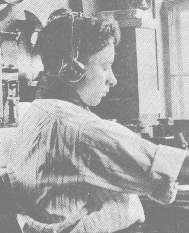 a shtetl
of Uzlian in Russia. Needless to say, they were very poor. In 1896, Abraham came to the
United States with a large influx of other Russian Jews. The idea was to make enough money
to bring the rest of the family over in time. David would not see his father again for
four years. During this time, his mother sent him off to his grandmother's brother who was
a rabbi to teach him to become one himself. He spent four years eating and sleeping the
"Talmud". He literally had to sing for his supper. If he missed a portion of his
memorization, he did not eat. Even though he hated this strict regimen, he said later in
life that it served him well in business. a shtetl
of Uzlian in Russia. Needless to say, they were very poor. In 1896, Abraham came to the
United States with a large influx of other Russian Jews. The idea was to make enough money
to bring the rest of the family over in time. David would not see his father again for
four years. During this time, his mother sent him off to his grandmother's brother who was
a rabbi to teach him to become one himself. He spent four years eating and sleeping the
"Talmud". He literally had to sing for his supper. If he missed a portion of his
memorization, he did not eat. Even though he hated this strict regimen, he said later in
life that it served him well in business.
In 1900, his father had made enough money to bring the rest of his family over to the
United States. His father had endured some hard times in New York, doing menial jobs which
only sometimes included house painting or paperhanging. This did much in destroying his
health. Instead of coming over to the United States and into the harbor, his mother chose
a cheaper much longer way of getting to the United States. They finally arrived in
Manhattan on July 2,1900. Through a mixup in communications, Abraham was waiting for them
at a different dock. They finally met up later that evening. The family was quite shocked
at the sheer magnitude of the city. They obviously had never seen anything so huge as the
city of New York in their lives. They also were shocked to see the poor health David's
father was in. Their new home was a fourth story flat on Monroe Street on the lower East
Side. Obviously Abraham had not fared too well in America. David saw the squalor they
lived in and decided that he had to do something about it. At nine years of age, he was
going to have to become the family breadwinner.
David began selling Yiddish newspapers every afternoon at a penny a piece. For every
fifty papers he sold, he received a quarter. In order to be successful, he had to beat out
other boys in covering the territory before they sold theirs. In order to make more money,
he took up delivering another paper in the morning. At 4:00 a.m. every morning he would
wake up and grab the bundle of papers as they were tossed from the elevated train. He
trained himself to wake up at the sound of the oncoming train. His days were filled with
delivering newspapers, with little time in between to study and read. On weekends he made
extra money singing in his synagogue. He also enrolled in English classes at the
Educational Alliance. This was a school set up by German Jews who had come to the United
States in the 1800's. David spent much time in the school's library and attending lectures
held at the school auditorium. After only five months in America, he had learned enough
English to read the English newspapers. By the time he was old enough for his bar-mitzvah,
he had developed into a proficient speaker. He was also busy learning how to become an
entrepreneur. He opened a newspaper stand at age fourteen with money which was anonymously
given to him. He put his brothers to work as well as his ailing father. By his fifteenth
birthday, he graduated from elementary school. High school was out the question and his
father was near death. This meant that the responsibility of supporting the family fell
upon him.
David decided that he would try to get a job with one of the newspapers in town as a
reporter. He went to the paper he admired most, the New York Herald. He made his
way uptown to the building of the Herald but went into the wrong office. He ended
up in the office of the Commercial Cable Company. A mistake he never regretted.
He delivered messages to the Herald and other businesses around town on a
bicycle which the company provided. He didn't keep this job very long though, because when
he asked for a three day leave of absence for Rosh Hashanah and Yom Kippur, his boss said
no. David protested his boss's decision and was fired. This was one of his first but not
his last run ins with anti-semetism.
It was during his time at the Commercial Cable Company that he first saw the telegraph
key. He became very interested in it and with one of his first paychecks he purchased his
own key. From this time on he was never far from a telegraph key. Through hours of
practice, he developed one of the best fists in the business. After being fired from the
Commercial Cable Company, he applied for a job with the American Marconi Wireless
Telegraph Company as a junior telegraph operator. Working for Marconi was the next best
thing to happen to David Sarnoff. He would work for Marconi and its successor, the Radio
Corporation for the next sixty years. American Marconi Telegraph Company was not a money
making company at the time. It was a money losing presence in America, for its parent
company in England.
Davey Sarnoff as he was known at the time didn't actually start out as a telegraph
operator. He started out as an office boy sweeping floors and running errands. He read
everything that he was supposed to file and soon learned everything there was to know
about the company. He even read letters from Marconi himself which allowed him to see how
the management worked firsthand. One evening in December,1906, Davey introduced himself to
Marconi as the newest employee of the American Marconi Telegraph Company. His bold gamble
of introducing himself paid off. Shortly after his sixteenth birthday, he was promoted to
junior wireless operator. Sarnoff was on his way to working himself up the ladder at
American Marconi Telegraph Company. He eventually worked his way up to Chief Inspector for
Marconi. It was in this position that he met a very important person in the new world of
radio.
Edwin H. Armstrong was an inventor who had been working on developing a receiver that
would pick up wireless signals better. Sarnoff and three other Marconi engineers went to
see a demonstration of Armstrong's new powerful "regeneration receiver." Sarnoff
and his engineers were amazed at this new device. They were able to pick up signals from
Glace Bay, Labrador and Clifden, Ireland. They also tuned in a station from San Francisco.
This made a great impression on Sarnoff. He and Armstrong immediately liked each other and
got to know each other better when they spent the last two days of January,1914 together
at a transmission station at Belmar, New Jersey. There they listened to transmissions from
around the world. Sarnoff reported to his superiors that this new receiver warranted
careful investigation of the patents because this device had advantages which unless there
were other systems out there which he was not aware of, it was the most remarkable system
in existence.
Sarnoff saw great potential with this new technology. Unfortunately, the higher ups
didn't feel the same way. Sarnoff saw a way of moving into a new field of
"broadcasting", sending a signal from one point to many receivers. Marconi said
that they were a point to point operation and were quite profitable in this procedure. In
1906, an inventor named Fessenden experimented transmitting voice over the air to wireless
receivers on boats. In 1914, Sarnoff experimented in sending music and voice to the
Wanamaker Dept. Store in Philadelpia. He accomplished this by putting a transmitter on the
roof of the Wanamaker building. In 1916 he sent a memo to Edward J. Nally, the
vice-president and general manager of American Marconi of prophetic sense that would take
Marconi Company sales into a new direction. "I have in mind a plan of development
which would make radio a household utility in the same sense as the piano or the
phonograph," said Sarnoff.
He wanted to bring music into the homes of America by wireless. Another problem with
Sarnoff's idea was timing, World War I was about to break out. He would have to put his
idea on hold until after the war.
After the war General Electric and American Marconi were discussing an important
business transaction. Marconi wanted to buy what was then the most powerful generator of
radio waves. General Electric held the patents and Marconi wanted to buy the exclusive
rights. Unfortunately the Navy did not want to see radio fall into the hands of foreigners
like the Marconi Company. Foreign companies already dominated the submarine wire industry.
It was through this problem that a new American company arose that Sarnoff was to
eventually come to run. On October 17,1919, the Radio Corporation of America, with the
patents of General Electric and Marconi, was incorporated in the state of Delaware.
Sarnoff was made the commercial manager of "RCA". He was now second in command
to Edward Nally. Nally relied heavily on Sarnoff to run RCA. He worked hard at capturing
back all the radio business that Marconi lost to the Navy during the war. He was also
instrumental in building a transmitter using one of the powerful generators acquired by
General Electric which would become the center of RCA's international radio
communications. All this led up to his ideas from before. He sent a twenty-eight page memo
to Owen D. Young, the once vice-president of General Electric and now chairman of RCA
which shared Sarnoff's vision. His memo contained nine sections with headings like
"Patent Situation," "Marine Business," "Sales to Amateurs,"
and "Sales and Merchandising Policies." It stood as a blueprint for making RCA a
dominant radio company in the world.
RCA began building radios and the radio craze took off. RCA had competition with
companies like Westinghouse who built radio stations first then built a demand for the
product with broadcasts. Although this sometimes made things difficult for RCA it helped
in that it redefined RCA as a broadcaster and a radio manufacturer as well as an operator
of international telegraph communications. Sarnoff reveled in the fact that it was he that
had the vision to see where broadcasting would take RCA. In 1921, Howard Armstrong came up
with another discovery. This he called super regeneration. Although it had some bugs to be
worked out, Sarnoff didn't want to lose the patents to it like the ones he had lost to
Westinghouse. He moved aggressively to purchase rights to the invention from Armstrong.
Instead of working with lawyers and middlemen, he went straight to Armstrong. Sarnoff soon
found out though that Armstrong was a tough bargainer. Sarnoff eventually obtained the
rights by using cash and stocks. This made Armstrong the largest private stockholder in
RCA at the time. To avoid letting Armstrong get the best of him again he insisted that
Armstrong from now on give RCA first refusal of any future inventions. In 1923, RCA was
having some problems with another invention of Armstrong's which RCA obtained from
Westinghouse. The "superheterodyne" circuit which worked well was too complex to
manufacture. Sarnoff asked Armstrong to simplify it . Armstrong was successful and
received another 20,000 shares of stock to add to his already 60,000 shares.
In the late 1920's, radio had become a household item. Sarnoff had seen many changes at
RCA. The creation of the National Broadcasting Company, a new president of the
corporation, threats by the government with regulation, and increasingly under attack as a
monopoly. RCA needed someone to run it that was well known. Edward Nally stepped down as
president and Owen Young picked a new president in 1923 by the name of James Harbord.
Sarnoff was also appointed vice-president, he was 31. Although he was not president, it
fell on his part to train Harbord about the radio industry. Radio was having a profound
effect on the country. He didn't remain president for long. The stock market crash of 1929
left Owen D. Young in financial problems. He stepped down as chairman and Harbord filled
his spot . Owen knew that RCA needed someone like Sarnoff to keep things going. On January
3,1930, David Sarnoff became the third president of RCA, He was 39.
Sarnoff's next idea in where to go with radio was supplying sight with sound. He wanted
to get into the field of television. Unfortunately, many years would pass before this came
to fruition. To help him on his way, he recruited a man by the name of Vladimir K.
Zworykin. He was destined to be the greatest engineer at RCA. Also about this time the new
RCA building was built in 1933. It was the tallest building at the time. Sarnoff had his
office on the 53rd floor . It was a corner office with windows facing the north and west.
His office had everything you could possibly imagine. It had a secret wall that led to a
room with a barber chair, where he was serviced daily. This room also held a wardrobe, a
toilet and a shower. At his desk he had a telegraph key installed so he could communicate
to a wireless friend named George Winterbottom who was head of the RCA Communications on
Broad St. The most interesting fact about this new building was the large red neon
"RCA" logo on the building above his office.
The Rockefellers who built this building didn't even have their name on their building.
But they felt that RCA and Sarnoff had saved them. John D. Rockefeller wanted to build a
Metropolitan Opera at the center of a large commercial development in midtown Manhattan.
Unfortunately when the stock market crashed, the opera abandoned the project. Even though
sales had slipped for RCA at this time, it was still making quite a bit of money from NBC.
Through negotiations with Sarnoff and Young, they made arrangements for radio to take the
opera's place and for many of the buildings in the center to be known as "Radio
City".
In December, 1933 Sarnoff met with Armstrong at Sarnoff's office. Together they drove
out to Columbia University where Armstrong was working on another project. Armstrong had
always hated the static that was inherent with radio and was trying to clean it up. What
he came up with was "FM", Frequency Modulation. Up until then radio consisted of
"AM", amplitude modulation. It was noisy and full of static when there were
lightning storms or other such atmospheric conditions. What Sarnoff saw was a room full of
tubes and wires. Sarnoff showed little interest. He was more interested in getting
television off the ground than a new revolution in radio. The friendship between Sarnoff
and Armstrong started to diminish. At the 1939 World's Fair Sarnoff introduced television.
World War II came and Sarnoff wanted to be a part. Anti-Semetism had left him out of
World War I , but by pulling a few strings , he was able to get commissioned . He was
instrumental in planning the radio communications for D-day. For his services, he was made
a General. A title which he would carry for the rest of his life and made sure everyone
knew. Armstrong also was a part of WWII. He voluntarily gave all his FM patents to the
government for the use of the war. As soon as the war was over, a new war started at home.
This one was between Sarnoff and Armstrong.
The war over FM was a battle that eventually killed Armstrong. In a statement by
Armstrong he said that he would fight til he was dead or broke. Sarnoff had been
instrumental in having FM which originally had been put in the 40-50 Megacycles range
moved up to the 88-108 Megacycles range. The old 40 -50 Megacycles range was filled by
Sarnoff's baby, television. This basically made all the radios that were built to work on
Armstrong's Yankee Network useless. This and some other spats over patent rights made
bitter enemies of Armstrong and Sarnoff. By 1954, Armstrong had spent millions fighting
the big RCA which had much time and money on its side. His patents on FM were running out
as well. In 1953, his lawyers urged him to settle. Unhappily he did. He wouldn't see the
money though until 1961. On January 31,1954, Armstrong jumped out of a thirteenth story
window. Sarnoff learned about the death of his once friend and made a statement, "I
didn't kill Armstrong." His death obviously had left him shaken. For five years the
annual reports of RCA contained a sentence "A patent infringement suit brought
against the Corporation and NBC,Inc. by Edwin H. Armstrong is pending in the District
Court of the United States for the District of Delaware." He knew what the litigation
was doing to his old friend ,but the corporate interests always prevailed.
Something Sarnoff was working on as well as television was the introduction of color
television. In May, 1954, Sarnoff announced to the shareholders that color television was
to be introduced in a 19" package. This was his final triumph, although it came with
many setbacks and frustrations. RCA was being hassled by Philco, Motorola, and
Westinghouse over the rights to RCA's color tube. Knowing when to settle, he agreed to add
all of RCA's 100 patents on color television to a pool of color patents that any
manufacturer could draw from royalty free. This allowed television sets to be built by
other manufacturers and proliferated the use of color broadcasts. Up until then NBC was
the main user of color programs. CBS only had a couple of programs and ABC had none.
In 1961,Zenith, the last holdout among manufacturers to build color sets, said they
would start making color sets. At this time, Sarnoff tripled RCA's advertising budget for
color television. He installed free sets in the White House, Blair House, and influential
offices of newspapers. He did everything he could to promote color television. It
eventually caught on. His investments in color began to pay off and color was becoming the
accepted medium. Sarnoff was now reaching his mid sixties.
Sarnoff was now concerned about his own future. He had achieved just about everything
he could possibly achieve, but he wanted more. He now looked into advancing his rank in
the military. Others had been promoted to Major General in the Reserves, why not he. He
made several attempts to be promoted but never made it. He would have to be satisfied with
just Brigadier General. He then went on to lobby for other medals and awards. He even
received a "Father of the Year" award. By 1965, he decided that a book about him
needed to be written. He employed the services of his cousin and personal friend Eugene
Lyons. After he read the first draft, he became upset with Lyon's because he felt he had
not portrayed him in the best of lights. In 1966, David Sarnoff was released. Most
reviewers felt it was hagiography. He then decided to have another book compiled about him
called Looking Ahead. This one didn't go over very well either. Although his books
weren't going over very well, he had another idea of how to keep his legacy alive.
David Sarnoff had several children. One of whom was Robert Sarnoff. David Sarnoff more
or less manipulated RCA in to grooming Robert for David's position as president of RCA. On
January 1, 1965, Robert Sarnoff became president of RCA. David Sarnoff became the chairman
of the board. One of Robert's first changes to the company was the change of the RCA logo.
The old encircled letters underscored by a lightning bolt gave way to large bulbous
squared letters. The secondary trademarks of Nipper and "His Master's Voice,"
were put aside as well. Finally, the very name of Radio Corporation of America was done
away with as well. From now on it would be known as RCA Corporation. David was not happy.
He threatened to call a meeting to have the name reinstated. Robert relented and the old
name stayed, although it was hardly used. RCA changed in a number of ways. RCA used to be
a radio company with little interests outside of this world. Now RCA had become a
conglomerate, acquiring such companies as Hertz Rent-a-car, Random House Publishing, and
Banquet Foods. Earnings made on color television started to diminish.
Sarnoff's health was starting to diminish. In 1968, he came down with shingles. This
was a prelude of things to come. He developed an infection in his mastoids. He had several
surgeries to try and cure it but it didn't work. It eventually spread to his nervous
system. It slowly ate away his ability to see, speak, or hear. In 1970, he was moved to
his house to die. He eventually died on December 12,1971.
Sarnoff had spent his whole life trying to make something for himself. Along the way he
made a lot of enemies. He also made a lot of advancements in the world of
"broadcasting." His foresight allowed him to plan for the future of radio and
television, as well as become the head of one of the largest companies around, RCA. Return
to Last Page |
| Will
Rogers
William Penn Adair Rogers was born on November 4, 1879, in Indian Territory, an
area of land that later w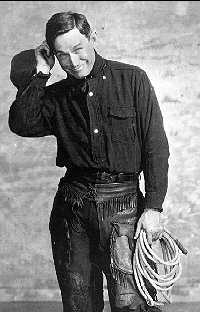 ould
become known as Oklahoma. His father, Clem Rogers, was a sucessful rancher, cattleman and
banker. The Rogers ranch and Will's birthplace still stand and is now a tourist attraction
near Oologah, Oklahoma. ould
become known as Oklahoma. His father, Clem Rogers, was a sucessful rancher, cattleman and
banker. The Rogers ranch and Will's birthplace still stand and is now a tourist attraction
near Oologah, Oklahoma.
Known as the "Indian Cowboy" from the Cherokee Nation, Will was to become the
most popular and best loved American of his time...the entertainer of kings and commoners
alike. As a young man, Will became an expert rider and "rope twirler"...later
starring in wild west shows and vaudeville around the World.
He went to Hollywood in 1918 and starred in many features and shorts in silent cinema.
After the advent of sound, Rogers rapidly became a top box office attraction. In 1934 he
was voted the most popular male actor in Hollywood.
Will's popularity spread to other media, notably radio and the press, in which his
political commentary carried much weight among citizens and politicians alike. He declined
a nomination for the governorship of Oklahoma, served as mayor of Beverly Hills, and was
instrumental in the election of FDR as President in 1932.
Will Rogers married Betty Blake in November 1908 after an 8 year courtship. He would
say, "When I roped her, that was the star performance of my life". One son,
actor-entertainer Will Jr., played his famous father in "The Story of Will
Rogers" in 1952. Will Rogers died in a plane crash near Point Barrow, Alaska with his
good friend, aviation legend Wiley Post in August 1935. Return
to Last Page |
| Roy
Rogers
Roy Rogers was born Leonard Slye in 1911 in Cincinnati in a building that stood near
where second base of Rive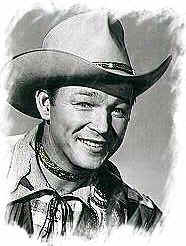 rfront Stadium is now located. His father worked in the insole
department of the United States Shoe Co., and also grew vegetables. Young Leonard dreamed
of becoming a dentist. The family was hit hard by the depression and headed west. Rogers
said that The Grapes of Wrath could have been his family's biography. Once in California,
he sang in cowboy music groups to supplement his meager income, and founded the seminal
group "The Sons of the Pioneers." For a while he was known as "Cactus
Mac." rfront Stadium is now located. His father worked in the insole
department of the United States Shoe Co., and also grew vegetables. Young Leonard dreamed
of becoming a dentist. The family was hit hard by the depression and headed west. Rogers
said that The Grapes of Wrath could have been his family's biography. Once in California,
he sang in cowboy music groups to supplement his meager income, and founded the seminal
group "The Sons of the Pioneers." For a while he was known as "Cactus
Mac."
He was working in a haberdasher's shop one day when a customer demanded a cowboy hat
for a tryout in the movies. Rogers trailed the man to Republic Studios, sneaked on to the
set, and got hired. One of his first roles was the villain in a Republic movie starring
Gene Autry. The two became pals. In 1938 Autry staged a one-man strike against Republic
and Rogers became his temporary replacement. When Autry left Hollywood to fly fighter
planes in 1943, Rogers again stepped into his shoes. He became the "King of the
Cowboys," and made nearly 100 B-movie westerns, what the crossword puzzles call
"oaters." He married his frequent costar Dale Evans. The couple reproduced, and
also adopted eight children. In the 50s Rogers moved to TV. Roy and Dale became well known
for their Christian (and also anticommunist) beliefs and spoke at Billy Graham revivals.
Dale wrote inspirational books. Rogers was worth somewhere north of $50 million at his
death. His last words were "Well Lord, it's been a rough ride." Return
to Last Page |
| Ringling
Brothers
NOTE: All seven brothers and their father were Masons
The Ringling Brothers Circus was founded by five of the seven Ringling
brothers. Albert C. (1852-1916), Otto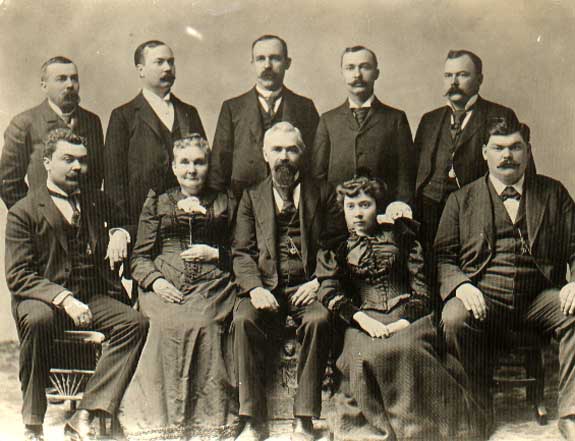 (1858-1911), Alfred T. (1861-1919), and Charles
Edward (1863-1926) were all born in Mcgregor, IA. John (1866-1936) was born in Baraboo,
WI. The two other brothers were never associated with the circus. (1858-1911), Alfred T. (1861-1919), and Charles
Edward (1863-1926) were all born in Mcgregor, IA. John (1866-1936) was born in Baraboo,
WI. The two other brothers were never associated with the circus.
While in Baraboo, the brothers started performing amateur musical
concerts. As they learned other entertainment skills they bought trained animals and
started a wagon show in 1884. Six years later they started using railway cars and in 1907
they bought the Barnum & Bailey circus. The two shows were kept separate until wartime
shortages made them decide to combine them in 1918. Thus was born The Ringling Brothers
and Barnum & Bailey Circus which became know as The Greatest Show On Earth.
Charles Ringling was the most Prominent of the brothers. After his death
in 1926 John succeeded him as director of the circus. When John died his nephew John
Ringling North took his place and became director in 1937.After being an opera singer from
1922 to 1939 the son of Charles, Robert Edward Ringling, turned to the family circus and
became president of the company in 1943. Return
to Last Page |
| Tom Mix
Mr. Tom Mix, a native of Denmark, came to America in 1992 to head-up the international
subsidiary of Aeroglide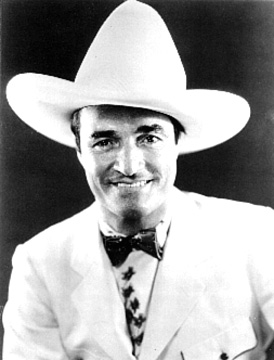 Corporation. Aeroglide designs and
manufactures driers and thermal processing equipment at their headquarters in Cary, North
Carolina. This equipment is sold primarily in the food/feed industry but has many other
applications. Corporation. Aeroglide designs and
manufactures driers and thermal processing equipment at their headquarters in Cary, North
Carolina. This equipment is sold primarily in the food/feed industry but has many other
applications.
Mr. Mix is proficient in six languages. He holds two business degrees and one liberal
arts degree, all from schools in Denmark. Prior to joining Aeroglide, he was responsible
for developing and managing a world-wide network of manufacturers’ representatives
for Pedersen Maskinfabrik A/S and Rockwool A/S. His travels have taken him around the
world quite frequently.
During his five years at Aeroglide, Mr. Mix has turned international sales around so
that Aeroglide’s exports today are more than 40% greater than that of the entire
Corporation in 1992. This has been achieved primarily through a proactive approach of
target countries and target markets, restructuring the internal sales department, and
utilizing multiple sales vehicles.
Return
to Last Page |
| Louis
B. Mayer
Studio mogul. Probably the most famous and feared of the moguls, Louis Bert Mayer had
the humble beginnings of  most immigrants who
became enormously successful in the United States. Born Eliezer (Lazar) Mayer, his father
was a simple laborer who foresaw a better life in America and moved his family here when
Mayer was just a child. His father became a junk dealer and parlayed his business into a
profitable scrap metal operation. Louis joined the family business when he graduated from
elementary school - he preferred his education through the school of hard knocks. He was
tough, smart, ambitious and gave as good as he got. most immigrants who
became enormously successful in the United States. Born Eliezer (Lazar) Mayer, his father
was a simple laborer who foresaw a better life in America and moved his family here when
Mayer was just a child. His father became a junk dealer and parlayed his business into a
profitable scrap metal operation. Louis joined the family business when he graduated from
elementary school - he preferred his education through the school of hard knocks. He was
tough, smart, ambitious and gave as good as he got.
Louis had more ambition in him than the scrap metal business could offer. In 1907, he
took a gamble on buying a rundown movie theater in Boston for peanuts. His renovations
turned the shabby building into a beautiful one. To complement the transformation, he
decided to present only high-quality films. These two elements were the first stepping
stones to his success in the movie industry. With his father's sense of business acumen,
he was able to build the largest theater chain in New England from this one theater. By
1914, his chain was a major concession for film exhibitors. However, this was not the
capping of his success by any means. Mayer benefitted, as many exhibitors would, from the
incredible success of D.W. Griffith's Birth of a Nation (David W. Griffith Corp, for Epoch
Producing Corp., 1915). He made a huge profit exhibiting this monumental hit, which would
form the basis of his true rise to power in all things Hollywood.
Having satisfied his goal to become the top exhibitor on the East Coast, he felt the
fever that overtakes all who are fascinated with the challenges of actually producing the
films for exhibition. In 1917, he threw his hat into the ever-expanding ring of movie
production. By 1918, he was in Los Angeles promoting his films, through his company Louis
B. Mayer Pictures, with his sole leading lady, Anita Stewart. His first production,
Virtous Wives (Anita Stewart Productions, for First National, 1918), pleased the public,
made an overnight star of Miss Stewart and stoked the unquenchable fire that burned in
Mayer's belly. For five years, with Miss Stewart as his prominent attraction, Mayer
learned the business and the lay of the Hollywoodland. These early days of hustle and
bustle were a simpler, happier time. Since Louis had made a fortune with his theater
chain, he bankrolled his own productions. He was settled in a little studio that once
belonged to "Colonel" William N. Selig, an earlier pioneer of film. Moviemaking
is an expensive venture, and compelled the producer to work in modest conditions. He
shared this space with another filmmaker of fierce ambition, B.P. Schulberg, who was a
expatriate of Adolph Zukor's Paramount. Schulberg's quest for creative independence
inspired him to form his Preferred Pictures. In those simpler, happier times, according to
Budd Schulberg, B.P.'s son, both families enjoyed a mutual affection for one another and
thrived in their work. After a few years, the work would continue; the mutual affection
would not. The baby moguls were growing up into insatiable power mongers.
1924 was a fateful year for Louis B. Mayer and the motion picture industry. The most
powerful Hollywood mogul of all lived and cut deals 3000 miles away in New York City. His
name was Marcus Loew. He was an astute financier and was truly the real power behind the
throne of moguldom. Enjoying the kind of pastimes that CEOs relish, he played the merger
game with his studio Metro, Louis B. Mayer Productions, and the Samuel Goldwyn Company to
form the foundation for M-G-M. Goldwyn backed out at the beginning, preferring to maintain
his independence, but M-G-M sounded better than M-M! The Goldwyn name, without Sam, was
retained. Loew appointed Mayer Vice President and teamed him with the young and creative
producer that he lured from Universal, Irving Thalberg (1899 - 1936). The two men could
not be more opposite in temperment and physical stature, but they understood one another
on the level of ambition and the promotion of quality and quantity. These two men would
set the standard of picture making and stir up the pot of competition for the attention
and attendance of the public.
Ephraim Katz, the late respected film scholar and author of the classic resource, The
Film Encyclopedia (Thomas Y. Crowell Publishers, 1979), eloquently encapsulated the
phenomenon of Louis the Conquerer:
A ruthless, quick-tempered, paternalistically tyrannical executive, Mayer ruled M-G-M
as one big family, rewarding obedience, punishing insubordination, and regarding
opposition as personal betrayal. He made many enemies during his reign, but also many
admirers of his indefatigable capacity for work and his total devotion to his studio. He
wasn't well- read and abhorred intellectualism, but he had an uncanny intuitive sense of
mass taste and a knack for selecting and handling personnel.
The sign of a clever auteur is to achieve the illusion that there is a sole individual
responsible for magnificent creations that require thousands of people to accomplish.
Mayer was a very visible patriarch to his "studio children" and to the public at
large. A frustrated actor himself, he enjoyed performing both publically and privately.
The thoroughbred stable of stars that were engaged at the very beginning of the M-G-M
enterprise, many who came from Metro Pictures, like Lon Chaney, John Gilbert, Norma
Shearer, Eleanor Boardman, William Haines, Mae Murray and Ramon Novarro, were certainly
manipulated by this crafty master. Leading directors, like Robert Z. Leonard, Erich von
Stroheim, Marshall Neilan, Fred Niblo, King Vidor and Monta Bell, also were not spared
from this mogul's manipulations. Mayer was involved in all aspects of production and
personally enjoyed the machinations it took to keep his people on their best behavior.
Even though Irving Thalberg was indisputably the brainchild behind the
"artistic" thrust of the quality of the stories that were filmed, he chose to
exercise his powers more discreetly. However, Thalberg was no less ruthless in his covert
quest for success. Both men would vie for the scepter in a quiet, but vicious power
struggle. Mayer's control of the industry extended beyond the studio gates. In 1927, an
uneasy truce was declared as various factions came together to form the Academy of Motion
Pictures Arts and Sciences - the backbone of this industry of artisans. Mayer was one of
the key creators, along with Douglas Fairbanks, Sr..
As M-G-M became more powerful, their output became overwhelming. They promised one
feature picture a week, 52 weeks a year. This did not include the scores of films produced
every month for programmers, advertisements and other less prestigious productions. M-G-M
created the company town of Culver City, California, and employed thousands of artisans
who were privileged to walk through the gates of the great studio and spend their lives
creating the stuff of which dreams are made. However, nightmares were going on behind the
scenes. Louis the Conquerer was purging his own ranks with the help of the talkies. He had
begun a personal campaign of elimination to rid himself of upstarts and washouts. Many of
these performers and directors were his discoveries or had had their careers substantially
uplifted by the touch of Mayer's wand. Some of the bloody sacrifices included Erich von
Stroheim, Marshall Neilan, Tod Browning, John Gilbert, Buster Keaton, Karl Dane, Mae
Murray, William Haines, Lillian Gish, Ramon Novarro and Nils Asther. Mayer even attempted
to topple the queen of the lot, Greta Garbo, from her throne. It was not a pretty sight.
Even Irving Thalberg was forced to acquiesce, due more to failing health than his desire
to let Mayer have his way. By 1936, the young Thalberg was dead and there was nothing to
keep Mayer from claiming all the spoils of M-G-M.
For the rest of the 1930's and through the 1940's, the other major studios ran hard to
keep up with the M-G-M glamour factory. The studio was like the glory of ancient Rome, and
all roads led to Louis B. Nero. As history has shown us again and again, great
civilizations fall due to the egos of mere mortals. Mayer was becoming a victim of his own
ruthlessness. A younger and hungrier generation of ambitious executives were invading the
ranks. Past successes could not guarantee holding on to the seat of power. Mayer's
attentions were also wandering and his power of judgment was beginning to fail him. He had
invested too much of himself as main overseer of the M-G-M plantation to delegate
responsibility at this late date. In 1951, he was ousted from M-G-M and replaced by a
different, postwar breed of producer, named Dore Schary. Mayer fought for the remaining
six years of his life in a futile attempt to convince the stockholders of Loews, Inc., the
controlling company of M-G-M, to rebel because of his dismissal - Louis the Conquerer was
vanquished.
Mayer died of complications of leukemia in 1957. At the height of his power, he was the
highest paid executive in the United States. His glamour factory influenced world leaders
and their vast minions. Louis B. Mayer has been gone for 40 years, but his name still
creates a sensation - he would have liked that. In his life, which was his studio, he was
attended by his faithful lieutenants, who rose to power along with this mogul. Where he
rests in the mausoleum at Home of Peace, in Los Angeles, many of those same faithful
lieutenants rest in adjacent crypts. Who says you can't take it with you?
Return
to Last Page |
| Harold
C Lloyd
Harold Clayton Lloyd was born in Burchard, Nebraska, USA, on April 20, 1893, the second
son to James Dars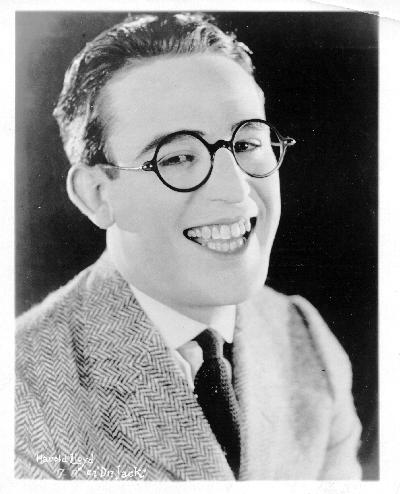 ie Lloyd
and Elizabeth Fraser. During his childhood, he lived, at various times, in the towns of
Pawnee City, Humboldt, Beatrice and Omaha, Nebraska, and Fort Collins, Durango and Denver,
Colorado. The reason for this nomadic existence was his father's difficulty in keeping a
job; it was this inconsistency that led Elizabeth to divorce her husband, nicknamed
"Foxy," in 1910. The two boys (elder brother Gaylord was born in 1888, and died
in 1943) shuffled between mother and father for a time, before making permanent home with
Foxy. ie Lloyd
and Elizabeth Fraser. During his childhood, he lived, at various times, in the towns of
Pawnee City, Humboldt, Beatrice and Omaha, Nebraska, and Fort Collins, Durango and Denver,
Colorado. The reason for this nomadic existence was his father's difficulty in keeping a
job; it was this inconsistency that led Elizabeth to divorce her husband, nicknamed
"Foxy," in 1910. The two boys (elder brother Gaylord was born in 1888, and died
in 1943) shuffled between mother and father for a time, before making permanent home with
Foxy.
Throughout Harold's childhood, he shared with his mother a passion for the theatre, and
engaged in amateur theatrics for most of his adolescence. In 1906, young Harold had met
the single greatest influence on his histrionic art: actor and mentor John Lane Connor,
who took the youngster under his wing and engrained in him the desire for perfection which
was to stay with Lloyd for the rest of his life. With each role Harold played, his notices
got stronger, and his zeal for theatrics grew alongside.
In 1912, Foxy, now working for the Singer Sewing Machine Company, had an accident, which
produced a monetary settlement of three thousand dollars. With this money, the Lloyd men
could really live, but the question was: where? The flip of a coin sent the men to San
Diego, California, where Connor had established a dramatic school, which Harold joined
immediately, as both a student and an instructor.
Later that year, after the dramatic school closed, Harold and some of the other students
took roles in The Old Monk's Tale, a production of The Edison Company. This brief role as
a Yaqui Indian was the film debut of Harold Lloyd, and was followed by sporadic extra work
with Edison, Keystone and Universal. While at Universal City, Lloyd met a fellow extra,
Hal Roach, who would later establish his own production house, The Rolin Film Company, and
take on Lloyd as principal talent. Together, the young men would learn how to make films,
and would grow to virtually define film comedy in the process.
Harold Lloyd's first real comedy character was Willie Work, whose appearance was directly
patterned after the Tramp, portrayed by Charles Chaplin. With this character, at least six
films were released, though many more were made. The next character, Lonesome Luke, varied
the Tramp theme somewhat, by employing tight clothes, two-dot mustache, and wide smile.
Lloyd was never happy with this persona, though seventy-one films were released, to the
delight of Roach and distributor, Pathe. A newer, better, and more unique character was in
Lloyd's mind, as early as 1916, but it was a year later, after threatening to quit, that
Roach allowed Lloyd to try out the new persona, dubbed The Glasses Character. This role,
which put a normal-looking boy onto the screen, with the single defining characteristic
being a pair of lenseless horn-rimmed glasses, came to change the standard definition of
comedy at the time. No more did a character have to be quirky, grotesque, or
out-of-the-ordinary in order to be funny: Lloyd proved that.
From the beginning, the new character found favor with audiences. With each film, as was
true in Harold's early theatre days, reviews got more and more favorable. In April 1919,
Lloyd signed a contract for a series of longer, and more sophisticated, two reel comedies,
at a greater salary. Life seemed to be just starting for the comic.
Then came August 24, 1919, a day that found Harold posing for publicity stills at Witzel's
Photographers, Los Angeles. One shot called for Lloyd to light a cigarette from a prop
bomb, striking a sassy, devil-may-care pose. The prop, though, so resembled a real bomb
that an actual real bomb got mixed in with the fakes -- the real bomb was handed to Lloyd.
He lit the already-lit cigarette onto the wick, but found that the excessive smoke
prohibited a good picture. As he signaled for a new wick, the bomb exploded. The force of
the blast temporarily blinded Lloyd, and severed the thumb and forefinger from his right
hand, and kept him out of the studio for almost seven months. Thanks to the input of
former glove salesman Sam Goldwyn, Lloyd's impairment was covered within a prosthetic
glove. At no time did Lloyd ever discuss the loss of the fingers, even in his 1928
autobiography, An American Comedy, or in numerous interviews and oral histories. The
reason for this was that, at no time, did Lloyd want his fans to know about the
disability, for he did not want his audiences to come to see him out of pity, or sympathy,
or curiosity. He wanted people, simply, to laugh with him. Rather remarkable, considering
the box office potential...
The films kept on coming. Two reelers grew to three reelers, then to feature length with A
Sailor-Made Man in 1921. Eleven silent features were released between 1921 and 1928. Seven
sound features followed from 1929 through 1947. All the films took The Glasses Character
to new heights, exploring a wide array of situations, but all featuring the optimistic
go-getter whose enthusiasm got him out of scrape after scrape. Obstacles were laughed at,
while the audiences rolled in the aisles. The sound era saw a decline in Lloyd's
popularity, mainly because the optimism of the character lost the appeal of Depression
audiences.
Lloyd married his leading lady, Mildred Davis, on February 10, 1923, and together they
raised three children. Gloria, born in 1923, still lives in California. Peggy, adopted in
1930, died in 1986. Harold, Jr., born in 1931, died three months after his father in 1971.
The Lloyd family lived in Beverly Hills at Greenacres, their spectacular sixteen-acre
estate.
Throughout his life, Lloyd investigated, and mastered, a staggering number of hobbies,
among them stereo photography, bowling, dog breeding, color research, magic, tennis, golf,
painting, microscopy, and handball. In 1924, he and his father joined The Ancient Arabic
Order of the Nobles of the Mystic Shrine, known as "The Shriners". In 1949,
Harold was elected Imperial Potentate, the highest national office. During his year-long
term, and to the end of his life, he worked tirelessly on behalf of The Shriner's
Hospitals for Crippled Children, and helped more people than he ever realized.
In 1962, Lloyd released the first of two compilation films, entitled Harold Lloyd's World
of Comedy, which re-introduced his beloved Glasses Character to new generations. At this
time, as well, he began touring colleges and high schools, showing his films to young
audiences, who marvelled at his comic antics. This brought Lloyd a great deal of joy in
his later years.
Mildred Davis, Lloyd's wife of forty-six years, died on August 18, 1969, at 68. The next
year, Lloyd was diagnosed with prostate cancer, and underwent surgery and cobalt
treatments.
Harold Lloyd's final public appearance found him in London, at the Cinema City Exhibition
celebrating the seventy-fifth anniversary of film. He showed his classic, The Kid Brother,
to the cheers of appreciative audiences, who did not know how sick he really was.
Harold Clayton Lloyd died, at home at Greenacres, on March 8, 1971, at 77. He was entombed
in the Great Mausoleum at Forest Lawn Memorial Park, Glendale, California.
In 1984, the mansion at Greenacres was named to the National Registry of Historic Places.
In 1994, Harold Lloyd was one of ten Silent Screen Stars memorialized on a twenty-nine
cent postage stamp, along with Rudolph Valentino, Clara Bow, Charles Chaplin, Lon Chaney,
John Gilbert, ZaSu Pitts, the Keystone Cops, Theda Bara,and Buster Keaton. As generations
to come are introduced to Harold Lloyd's work and legend, he will continue to live on, and
will continue to represent the American Success Story. Return
to Last Page |
| Elmo
Lincoln
He was the first Tarzan. A former Arkansas peace officer, Elmo Linkenhelt worked in
D.W. Griffith's "The Battle of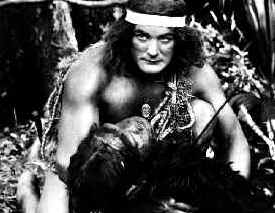 Elderbush Gulch" (1912).
In a fight scene his shirt was partially torn off, displaying his powerful chest. Griffith
noticed, called him over, and told him "That's quite a chest you have there".
Griffith changed the name to Elmo Lincoln and featured him in several of his films. He got
the role in "Tarzan of the Apes" when, a few days after production began, World
War I broke out an the man originally contracted to play Tarzan (Winslow Wilson - stocky
New York actor and ukelele player) walked off the set and enlisted. The film was a
boxoffice smash, one of the first to earn over a million dollars. The sequel "Romance
of Tarzan" just broke even. He did three successful serials and a feature for
Universal Film Manufacturing before returning in "The Adventures of Tarzan" in
1921, his last Apeman performance. His final silent performance was in a cheap Rayat
serial "King of the Jungle" (1927) after which he moved to Mexico and invested
in mining. He came back to play a number of bit parts and appeared briefly in the Seal
Brothers Circus as "The Original Tarzan in Person". In 1949 he had a part as a
fisherman in "Tarzan's Magic Fountain". Just before his death he had a bit part
in "Carrie" which starred one of his heroes, Lawrence Olivier. Return
to Last Page Elderbush Gulch" (1912).
In a fight scene his shirt was partially torn off, displaying his powerful chest. Griffith
noticed, called him over, and told him "That's quite a chest you have there".
Griffith changed the name to Elmo Lincoln and featured him in several of his films. He got
the role in "Tarzan of the Apes" when, a few days after production began, World
War I broke out an the man originally contracted to play Tarzan (Winslow Wilson - stocky
New York actor and ukelele player) walked off the set and enlisted. The film was a
boxoffice smash, one of the first to earn over a million dollars. The sequel "Romance
of Tarzan" just broke even. He did three successful serials and a feature for
Universal Film Manufacturing before returning in "The Adventures of Tarzan" in
1921, his last Apeman performance. His final silent performance was in a cheap Rayat
serial "King of the Jungle" (1927) after which he moved to Mexico and invested
in mining. He came back to play a number of bit parts and appeared briefly in the Seal
Brothers Circus as "The Original Tarzan in Person". In 1949 he had a part as a
fisherman in "Tarzan's Magic Fountain". Just before his death he had a bit part
in "Carrie" which starred one of his heroes, Lawrence Olivier. Return
to Last Page |
| Al
Jolson
American entertainer, whose original name was Asa Yoelson, born in Russia.He emigrated
to the United States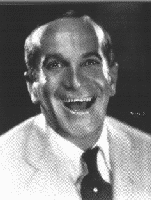 c.1895. The son
of a rabbi, Jolson first planned to become a cantor but soon turned to the stage. After
his New York City debut in 1899, he worked in circuses, in minstrel shows, and in
vaudeville; in 1909 in San Francisco he first sang "Mammy" in black face, and
his style brought him fame and many imitators. The first of his many Broadway appearances
was in La Belle Paree (1911); his film work began with The Jazz Singer
(1927), the first major film with sound and a landmark in the history of motion pictures.
After 1932 he had his own radio show. Among the songs he made famous were "April
Showers," "Swanee," "Sonny-Boy," and "Mammy." c.1895. The son
of a rabbi, Jolson first planned to become a cantor but soon turned to the stage. After
his New York City debut in 1899, he worked in circuses, in minstrel shows, and in
vaudeville; in 1909 in San Francisco he first sang "Mammy" in black face, and
his style brought him fame and many imitators. The first of his many Broadway appearances
was in La Belle Paree (1911); his film work began with The Jazz Singer
(1927), the first major film with sound and a landmark in the history of motion pictures.
After 1932 he had his own radio show. Among the songs he made famous were "April
Showers," "Swanee," "Sonny-Boy," and "Mammy."
Return
to Last Page |
| Harry
Houdini
Magic, escapes, fame and fortune: this is what comes to mind when think of Harry
Houdini. Houdini was a mas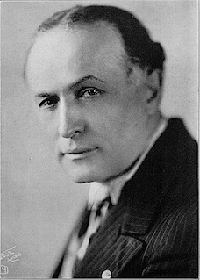 ter
magician as well as a superb escape artist. Houdini was so obsessed that no matter what
got in his way whether it was his parents, or anything that was crowding the view of his
goal, he pushed it aside. Many things got in his way but he was so focused, so determined
to be what he wanted to be, that he finally achieved his goal. He was rejected by the
general public early in his career. Harry Houdini struggled hard throughout his life to
achieve his fame and fortune. This struggle began as a child. Houdini obviously did not
give up on his career but something carried him. It might have been something that he
realized as an adult or it could be some quality that was instilled in him as a child. We
wanted to find out so, we examined this and we would like to show you what we found and
give you the conclusion we came to. ter
magician as well as a superb escape artist. Houdini was so obsessed that no matter what
got in his way whether it was his parents, or anything that was crowding the view of his
goal, he pushed it aside. Many things got in his way but he was so focused, so determined
to be what he wanted to be, that he finally achieved his goal. He was rejected by the
general public early in his career. Harry Houdini struggled hard throughout his life to
achieve his fame and fortune. This struggle began as a child. Houdini obviously did not
give up on his career but something carried him. It might have been something that he
realized as an adult or it could be some quality that was instilled in him as a child. We
wanted to find out so, we examined this and we would like to show you what we found and
give you the conclusion we came to.
Ehnric Weiss (Houdini) loved magic and escapes since childhood. Houdini loved to go to
the circus because the circus taught him everything he wanted to know about magic, magic
tricks and knot tieing. Within a few days, he joined that same circus. In this circus he
would astound people with his magic tricks. But to the people watching Houdini's tricks
,they were more than just tricks. They were no less than true magic. Magic was not all he
learned for he was taught to walk the tightrope. But to Houdini, the tightrope was
nothing, for magic and escapes were his one and only love. Houdini yearned to leave home
and join a large circus to practice his magic and escapes, but his family was poor and
needed his support more than he ever knew. Since Houdini's family was so poor he felt it
his duty to give them as much as he could financially and mentally. But, magic was his
main focus and, if he could use that to support his family and himself then that was great
but if not, so be it. The circus was no longer an ambition but becoming a full time
magician and escape artist was. He reasoned that if he was good enough he would be able to
support his family by sending them hundred dollar bills instead of one's. He put all of
the spare money that he earned into magic tricks.
Ehnric became a full time magician. He traveled around the states putting on shows from
Washington to Wisconsin. Unfortunately he didn't hit it off. People couldn't care less
about a Jewish magician! That's not what they wanted so, he wasn't an immediate success.
Many times he was at rock bottom living on little more than a few dollars, no assets or
means of living. He felt as if he let his family down because he could not send them money
in those times. He also felt like he left himself down. Houdini's dream began to die. Then
he started to focus on escapes. Once Houdini did this his career-sky- rocketed because
this was the exciting thing people wanted to see. He flew to Europe and made the headlines
escaping from many things such as Scotland Yard. He challenged people and jails to lock
him up and keep him there. As we all know by now he would escape.
Houdini's childhood influenced his adult success as an adult. He was committed to stick
to magic and escapes no matter what opinions he got from his parents or how little money
he had. Many times they told him not to keep playing with magic. They told him that his
dreams were unrealistic. But he kept going! His obsession and commitment is what got him
to the top. His first attempts were an absolute flop but he kept going. His life was like
a basketball game. Many times it looks like the game is over, your clock is running down,
your team is tired and there is no hope left. But, you expend your last bit of energy and
you prevail, the shot goes in. Then, you get to start over in the sense of an overtime.
You pull yourself together and if you win, you become a success. If you lose, you still
have pride because you know you tried. Houdini ended up winning the game of life. Just
like basketball it was passion, commitment and a will to win is what kept him going!
We believe Houdini's commitment was exemplary. He was always committed to his work some
of the time giving up his own free time. He displayed the quality of commitment from
childhood all the way through adulthood. Because of his never-say-die attitude, Houdini's
career was a success. We believe that without this attitude and his commitment, that the
Harry Houdini we know of now would not be the same. He would just be another escape
wanna-be or a never-was or maybe titled, a failure. But Harry was not deemed a failure of
a wanna-be but a success and his commitment as a child helped lead to his success. A
success that could only be contemplated by people like us.
Harry Houdini was a very interesting man. He devoted his whole life to magic and
escapes. Houdini's commitment amazes us all and is what led to his success. But this
quality was achieved as a child. There are few people who are capable of demonstrating
such commitment. This commitment started as a child and was with him until his death. He,
"refused to loose," and this was a form of commitment. His career was a success
because of an outstanding example of commitment.
Return
to Last Page |
Oliver Hardy
Ollie was born on the 18 Jan 1892 in Harlem, Georgia. He studied Law at the
Georgia State University and spent his time between studies singing at the Atlanta
Conservatory of Music. In 1913 Ollie expressed an interest in the new-found motion picture industry where he
began work with the Florida based 'Lubin Company'. It was in his early days with the Lubin
company that he picked up the nickname 'Babe'that was to stay with him for the rest of his
life. One of the many 'two reelers' that Babe appeared in was 'Lucky Dog' where he had a
brief encounter with Stan Laurel. It would be almost a decade before the boys would
feature togethor again. In 1926 Ollie, became member of Hal Roach Company (Oliver Hardy
starred in 252 films without Stan). After featuring togethor in the movie 'Duck Soup' the
boys transformed into the best comdey duo of cinema history. Their first feature-length
starring roles were in Pardon us (1931). After over two decades of success paired with
Stan, Ollie appeared without Stan in The Fighting Kentuckian (1949) and Riding High
(1950). Oliver Hardy died august 7th, 1957 following a major stroke which left him
seriously debilitated in the months before his death. Oliver's ashes were interred in the
Masonic section of the Garden of Valhalla Memorial Park in North Hollywood. motion picture industry where he
began work with the Florida based 'Lubin Company'. It was in his early days with the Lubin
company that he picked up the nickname 'Babe'that was to stay with him for the rest of his
life. One of the many 'two reelers' that Babe appeared in was 'Lucky Dog' where he had a
brief encounter with Stan Laurel. It would be almost a decade before the boys would
feature togethor again. In 1926 Ollie, became member of Hal Roach Company (Oliver Hardy
starred in 252 films without Stan). After featuring togethor in the movie 'Duck Soup' the
boys transformed into the best comdey duo of cinema history. Their first feature-length
starring roles were in Pardon us (1931). After over two decades of success paired with
Stan, Ollie appeared without Stan in The Fighting Kentuckian (1949) and Riding High
(1950). Oliver Hardy died august 7th, 1957 following a major stroke which left him
seriously debilitated in the months before his death. Oliver's ashes were interred in the
Masonic section of the Garden of Valhalla Memorial Park in North Hollywood.
Return
to Last Page |
| Harold
Lincoln Gray
Harold Lincoln Gray, the son of Ira L. Gray and Estella M. Rosencrans, was born in
Kankakee, Illinois, on Janu ary 20, 1894. His parents both died before he finished school in West
Lafayette, Indiana, where the family had moved. ary 20, 1894. His parents both died before he finished school in West
Lafayette, Indiana, where the family had moved.
He graduated from Public School in 1908, High School in 1912, and Purdue University
with a degree in engineering in 1917. Along the way, he was selling cartoons to the local
newspaper and farm journals while working hard construction jobs to pay his way through
school. Upon graduation, he went to Chicago and became a cub reporter for the Chicago
Tribune at $15 per week. He soon became a general handyman in the paper's art department,
but left to do his time in the service.
When he returned, he worked for five years as an assistant to Sidney Smith, the creator
of The Gumps, and learned his future trade from a master. He developed his own
ideas for a comic strip, and met with Captain Joseph Medill Paterson to discuss its
potential. Captain Paterson felt that there were enough young boy adventure strips and
told Gray to put a skirt on the kid and call her Little Orphan Annie.
Little Orphan Annie debuted in the special pink edition of the New York Daily News on
August 5, 1924.
Gray injected his own conservative beliefs into his strip. Little Orphan Annie was
highly motivated, fiercely independent, minded her own business, and believed in action.
In the years that followed, Gray created a family for Annie by introducing
"Daddy" Warbucks in 1924, Sandy in 1925, Punjab in 1935 and The Asp in 1937.
Gray also experienced some changes in his personal life. His first wife, Doris C.
Platt, died in late 1925. Four years later, he married Winifred Frost and they moved to
Connecticut as the comic strip prospered. Later, they spent winters in La Jolla,
California.
"Daddy" Warbucks and Harold Gray were diagnosed with cancer in 1967, and
while "Daddy" beat it, Gray died of cancer on May 9, 1968 after a 44-year career
of drawing and writing one of the world's greatest newspaper comic strips, Little Orphan
Annie. "Return to Last Page" |
| Arthur
Godfrey
American television personality, one of the medium's dominant stars throughout
the 1950s as host of variety shows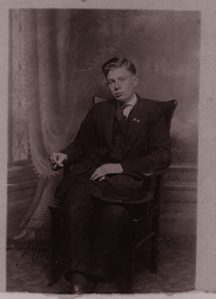 (programs made up of several separate
performances, including songs, skits, or comedy routines). He was born in New York City.
Columbia Broadcasting System (see CBS Inc.) hired Godfrey for its radio network in
the 1940s. When CBS began its TV broadcasts in the late 1940s, he was one of the first
performers to move to the new medium. He was known for his TV programs, "Arthur
Godfrey's Talent Scouts" (1948-1958) and "Arthur Godfrey and His Friends"
(1949-1959), and his popular radio show, "Arthur Godfrey Time" (1945-1972),
which was also televised from 1952 to 1959. (programs made up of several separate
performances, including songs, skits, or comedy routines). He was born in New York City.
Columbia Broadcasting System (see CBS Inc.) hired Godfrey for its radio network in
the 1940s. When CBS began its TV broadcasts in the late 1940s, he was one of the first
performers to move to the new medium. He was known for his TV programs, "Arthur
Godfrey's Talent Scouts" (1948-1958) and "Arthur Godfrey and His Friends"
(1949-1959), and his popular radio show, "Arthur Godfrey Time" (1945-1972),
which was also televised from 1952 to 1959.
Return
to Last Page |
| Clark
Gable
His mother died when he was seven months old. At sixteen he quit high school, went to
work in an Akron tire fac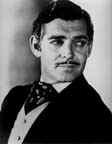 tory,
and decided to become an actor after seeing the play "The Bird of Paradise". He
toured in stock companies, worked oil fields and sold ties. In 1924 he reached Hollywood
with the help of Portland OR theatre manager Josephine Dillon, who coached and (twelve
years older) married him. After bit parts he returned to theatre, becoming lifelong
friends with Lionel Barrymore. After several failed screen tests (Barrymore and Zanuck) he
was signed in 1930 by MGM's Irving Thalberg. Joan Crawford asked for him as co-star in
Dance, Fools, Dance (1931) and the public loved him manhandling Norma Shearer in Free
Soul, A (1931) the same year. His unshaven love-making with braless Jean Harlow in Red
Dust (1932) made him MGM's most important star. The studio punished him for refusing an
assignment; he was farmed out to Columbia where he won an Oscar for It Happened One Night
(1934). He returned to substantial roles at MGM, winning nominations for Fletcher
Christian in Mutiny on the Bounty (1935) and Rhett Butler in Gone with the Wind (1939).
When his third wife 'Carol Lombard' died in a plane crash returning from a War Bond drive,
a grief-stricken Gable joined the Army Air Corps, out of movies for three years. When he
returned the studio regarded his salary as excessive and did not renew his contract. He
free-lanced, but his films didn't do well at the boxoffice. He announced during filming of
Misfits, The (1961) that, for the first time, he was to become a father. Two months later
he died of a heart attack. He was laid to rest beside Carole Lombard at Forest Lawn
Cemetery. Return to Last Page tory,
and decided to become an actor after seeing the play "The Bird of Paradise". He
toured in stock companies, worked oil fields and sold ties. In 1924 he reached Hollywood
with the help of Portland OR theatre manager Josephine Dillon, who coached and (twelve
years older) married him. After bit parts he returned to theatre, becoming lifelong
friends with Lionel Barrymore. After several failed screen tests (Barrymore and Zanuck) he
was signed in 1930 by MGM's Irving Thalberg. Joan Crawford asked for him as co-star in
Dance, Fools, Dance (1931) and the public loved him manhandling Norma Shearer in Free
Soul, A (1931) the same year. His unshaven love-making with braless Jean Harlow in Red
Dust (1932) made him MGM's most important star. The studio punished him for refusing an
assignment; he was farmed out to Columbia where he won an Oscar for It Happened One Night
(1934). He returned to substantial roles at MGM, winning nominations for Fletcher
Christian in Mutiny on the Bounty (1935) and Rhett Butler in Gone with the Wind (1939).
When his third wife 'Carol Lombard' died in a plane crash returning from a War Bond drive,
a grief-stricken Gable joined the Army Air Corps, out of movies for three years. When he
returned the studio regarded his salary as excessive and did not renew his contract. He
free-lanced, but his films didn't do well at the boxoffice. He announced during filming of
Misfits, The (1961) that, for the first time, he was to become a father. Two months later
he died of a heart attack. He was laid to rest beside Carole Lombard at Forest Lawn
Cemetery. Return to Last Page |
| W. C.
Fields
One of America's greatest comedians, W.C. Fields was a master mimic whose humor and
mock pompousness 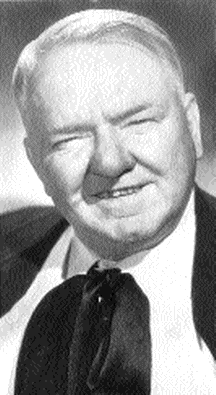 was
accompanied by a unique combination of a nasal drawl, wooden expression, and flawlessly
timed gestures. He ad-libbed, or made up as he went along, many of his radio and movie
scripts and maintained a cynic's role both on and off the screen. In motion pictures he
often played a heavy drinker who detested all children and dogs, wore a top hat and frayed
gloves, and carried a walking stick. was
accompanied by a unique combination of a nasal drawl, wooden expression, and flawlessly
timed gestures. He ad-libbed, or made up as he went along, many of his radio and movie
scripts and maintained a cynic's role both on and off the screen. In motion pictures he
often played a heavy drinker who detested all children and dogs, wore a top hat and frayed
gloves, and carried a walking stick.
Born Claude William Dukenfield on Jan. 29, 1880, in Philadelphia, at age 11 he ran away
from home. He began juggling tennis balls, apples, and stones and within three years had a
vaudeville juggling act that brought him considerable recognition. From 1915 to 1921 he
juggled in the Ziegfeld Follies on New York City's Broadway. In 1923 Fields switched to
comic acting on the stage and then in motion pictures, where his years of practice with
pantomime made him an overnight success. He moved to Hollywood and wrote, directed, and
starred in films. He played the "straight" role of Mr. Micawber in 'David
Copperfield' in 1935 and is remembered for 'The Bank Dick' and 'My Little Chickadee' (both
1940) and 'Never Give a Sucker an Even Break' (1941). Fields died in Pasadena, Calif., on
Dec. 25, 1946. Return to Last Page |
| Douglas
Fiarbanks
Doug wasn't only a beautiful, dashing specimen. His acting was superb, his enthusiasm
infectious and his superior 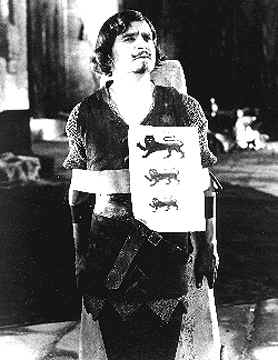 skill
as an athlete was described quite accurately as "poetry in motion." He had the
gift of creating the ultimate escape from the outside world inside the movie house. Each
of his surviving films is entertaining, interesting and just plain great good fun! His
screen persona always had a way with the ladies. When Doug pursued any beautiful woman,
she was as good as got. He could act believably in both contemporary stories and costume
dramas, slipping easily into any historical period. skill
as an athlete was described quite accurately as "poetry in motion." He had the
gift of creating the ultimate escape from the outside world inside the movie house. Each
of his surviving films is entertaining, interesting and just plain great good fun! His
screen persona always had a way with the ladies. When Doug pursued any beautiful woman,
she was as good as got. He could act believably in both contemporary stories and costume
dramas, slipping easily into any historical period.
Fairbanks really enjoyed making movies from the start of his screen career. From 1915
to 1920, he tried his hand at occasionally adapting his own scenarios. By the time United
Artists (the company he partly founded, in 1919, and actively participated in) was
operating very successfully, he found his niche in costume pictures. He knew what kind of
script worked best to showcase his persona. Beginning in 1922, he resumed writing and
wrote many of his own entertaining and creative story lines under the pseudonym of Elton
Thomas (his two middle names). These feature films included: Douglas Fairbanks in
Robin Hood (United Artists, 1922), The Thief of Bagdad (1924), The Black
Pirate (1926), The Gaucho (1927) and The Iron Mask (1929).
Doug lived very much like a great and beloved king. He was an active member of society
and worked towards the betterment of his beloved Southern California, as well as the movie
industry - cofounding Beverly Hills, United Artists and the Academy of Motion Picture Arts
and Sciences. He was a world traveler and, with his queen Mary Pickford, thrilled the
imagination of people all over the globe. It seemed as if this dynamic individual would
outlive all his contemporaries. However, the world was stunned when the man who lived life
to the fullest was felled forever by a heart attack in 1939. He was in the planning stages
of his next film, The Californian - a homage to the golden state he loved (a film
he was set to produce starring Doug Jr.). As befits a king, he was publicly mourned. The
following account was issued by the UPI in the sad days following his passing and printed
in the New York Times on December 12, 1939:
The body of Douglas Fairbanks Sr. lay tonight in an ornately carved bed before a window of
his Santa Monica mansion which looked out on the vast Pacific. Through the night and day
came a procession of Hollywood great and the forgotten who had worked with and known
Fairbanks in his swashbuckling days. For hours Mr. Fairbanks' 150-pound mastiff Marco Polo
whined beside the death bed, refusing to move....
Film critic and essayist Alexander Walker crystallized the essence of the huge gap that
Doug left with his untimely passing in his book Stardom (Stein and Day, 1970)
The old gymnasium on the United Artists lot where he had held court over the years was
dismantled and turned into a more democratic establishment altogether - a dressing room
for extras. And so vanished the place where Doug played leapfrog with Babe Ruth, traded
punches with Jack Dempsey and Gene Tunney (who surely pulled theirs, just a little), where
he ran races with Joey Hay, where the Duke of Sutherland lay on the rubbing bench, the
King of Siam rode on his mechanical horse, the Duke of Alba crossed foils with him, Conan
Doyle used his punch bag, Prince George of England wrestled with him, Lord Louis
Mountbatten looked on at a game of basketball where...Prince William of Sweden did his
Swedish exercises. No one was left to inherit all this and initiate other eminent
personages into the lesson of joy through strength, no one felt up to it after Doug
departed. After all, a certain rank and style are needed to be able to challenge a champ,
coach a king or cheer on the nation.
In an appropriate tribute, the king was laid to rest in a beautiful memorial designed
by William Cameron Menzies, one of the industry's most creative set designers and the
genius behind the look of one of Doug's most beautiful features - The Thief of Bagdad
(United Artists, 1924). In Doug's final "set," a long, serene reflecting pool
leads the eye to a marble sarcophagus surrounded on three sides by fluted columns.
Standing in front of the tomb and facing north, one has an unobstructed view of the
Hollywood Hills and the famous Hollywood sign that was a landmark when Dougs Fairbanks'
star rose to the heavens so long ago. Return
to Last Page |
| Walt
Disney
During a 43-year Hollywood career, which spanned the development of the motion picture
medium as a modern American art, Walter Elias Disney, a modern Aesop, established
himself and his product as a genuine part of Americana. David Low, the late British
political cartoonist, called Disney "the most significant figure in graphic arts
since Leonardo DaVinci." A pioneer and innovator, and the possessor of one of the
most fertile imaginations the world has ever known, Walt Disney, along with members of his
staff, received more than 950 honors and citations from every nation in the world,
including 48 Academy Awards and 7 Emmys in his lifetime. Walt Disney's personal awards
included honorary degrees from Harvard, Yale, the University of Southern California and
UCLA; the Presidential Medal of Freedom; France's Legion of Honor and Officer d'Academie
decorations; Thailand's Order of the Crown; Brazil's Order of the Southern Cross; Mexico's
Order of the Aztec Eagle; and the Showman of the World Award from the National Association
of Theatre Owners. art, Walter Elias Disney, a modern Aesop, established
himself and his product as a genuine part of Americana. David Low, the late British
political cartoonist, called Disney "the most significant figure in graphic arts
since Leonardo DaVinci." A pioneer and innovator, and the possessor of one of the
most fertile imaginations the world has ever known, Walt Disney, along with members of his
staff, received more than 950 honors and citations from every nation in the world,
including 48 Academy Awards and 7 Emmys in his lifetime. Walt Disney's personal awards
included honorary degrees from Harvard, Yale, the University of Southern California and
UCLA; the Presidential Medal of Freedom; France's Legion of Honor and Officer d'Academie
decorations; Thailand's Order of the Crown; Brazil's Order of the Southern Cross; Mexico's
Order of the Aztec Eagle; and the Showman of the World Award from the National Association
of Theatre Owners.
The creator of Mickey Mouse and founder of Disneyland and Walt Disney World was born in
Chicago, Illinois, on December 5, 1901. His father, Elias Disney, was an Irish-Canadian.
His mother, Flora Call Disney, was of German-American descent. Walt was one of five
children, four boys and a girl.
Raised on a farm near Marceline, Missouri, Walt became interested in drawing at an
early age, selling his first sketches to neighbors when he was only seven years old. At
McKinley High School in Chicago, Disney divided his attention between drawing and
photography, contributing both to the school paper. At night he attended the Academy of
Fine Arts.
During the fall of 1918, Disney attempted to enlist for military service. Rejected
because he was only 16 years of age, Walt joined the Red Cross and was sent overseas,
where he spent a year driving an ambulance and chauffeuring Red Cross officials. His
ambulance was covered from stem to stem, not with stock camouflage, but with drawings and
cartoons.
After the war, Walt returned to Kansas City, where he began his career as an
advertising cartoonist. Here, in 1920, he created and marketed his first original animated
cartoons, and later perfected a new method for combining live-action and animation.
In August of 1923, Walt Disney left Kansas City for Hollywood with nothing but a few
drawing materials, $40 in his pocket and a completed animated and live-action film. Walt's
brother, Roy 0. Disney, was already in California, with an immense amount of sympathy and
encouragement, and $250. Pooling their resources, they borrowed an additional $500, and
constructed a camera stand in their uncle's garage. Soon, they received an order from New
York for the first "Alice Comedy" featurette, and the brothers began their
production operation in the rear of a Hollywood real estate office two blocks away.
On July 13, 1925, Walt married one of his first employees, Lillian Bounds, in Lewiston,
Idaho. They were blessed with two daughters: Diane, married to Ron Miller, former
president and chief executive officer of Walt Disney Productions; and Sharon Disney Lund,
who served as a member of Disney's Board of Directors and passed away in 1993. The Millers
have seven children and Mrs. Lund had three.
Mickey Mouse was created in 1928, and his talents were first used in a silent cartoon
entitled "Plane Crazy." However, before the cartoon could be released, sound
burst upon the motion picture screen. Thus Mickey made his screen debut in "Steamboat
Willie," the world's first fully-synchronized sound cartoon, which premiered at the
Colony Theatre in New York on November 18, 1928.
Walt's drive to perfect the art of animation was endless. Technicolor was introduced to
animation during the production of his "Silly Symphonies." In 1932, the film
entitled "Flowers and Trees" won Walt the first of his 32 personal Academy
Awards. In 1937, he released "The Old Mill," the first short subject to utilize
the multiplane camera technique.
On December 21 of that same year, "Snow White and the Seven Dwarfs," the
first full-length animated musical feature, premiered at the Carthay Circle Theatre in Los
Angeles. Produced at the unheard cost of $1,499,000 during the depths of the Depression,
the film is still accounted as one of the great feats and imperishable monuments of the
motion picture industry. During the next five years, Walt completed such other full-length
animated classics as "Pinocchio," "Fantasia," "Dumbo," and
"Bambi."
In 1940, construction was completed on Disney's Burbank studio. The staff swelled to
more than 1,000 artists, animators, story men and technicians. During World War II, 94
percent of the Disney facilities were engaged in special government work, including the
production of training and propaganda films for the armed services, as well as health
films which are still shown throughout the world by the U.S. State Department. The
remainder of his efforts were devoted to the production of comedy short subjects, deemed
highly essential to civilian and military morale.
Disney's 1945 feature, the musical "The Three Caballeros," combined live
action with the cartoon medium, a process he used successfully in such other features as
"Song of the South" and the highly acclaimed "Mary Poppins." In all,
81 features were released by the studio during his lifetime.
Walt's inquisitive mind and keen sense for education through entertainment resulted in
the award-winning "True-Life Adventure" series. Through such films as "The
Living Desert," "The Vanishing Prairie," "The African Lion," and
"White Wilderness," Disney brought fascinating insights into the world of wild
animals and taught the importance of conserving our nation's outdoor heritage.
Disneyland, launched in 1955 as a fabulous $17 million Magic Kingdom, soon increased
its investment tenfold. By its third decade, more than 250 million people were
entertained, including presidents, kings and queens, and royalty from all over the globe.
A pioneer in the field of television programming, Disney began production in 1954, and
was among the first to present full-color programming with his "Wonderful World of
Color" in 1961. "The Mickey Mouse Club" and "Zorro" were popular
favorites in the 1950s.
But that was only the beginning. In 1965, Walt Disney turned his attention toward the
problem of improving the quality of urban life in America. He personally directed the
design on an Experimental Prototype Community of Tomorrow, or EPCOT, planned as a living
showcase for the creativity of American industry.
Said Disney, "I don't believe there is a challenge anywhere in the world that is
more important to people everywhere than finding the solution to the problems of our
cities. But where do we begin? Well, we're convinced we must start with the public need.
And the need is not just for curing the old ills of old cities. We think the need is for
starting from scratch on virgin land and building a community that will become a prototype
for the future."
Thus, Disney directed the purchase of 43 square miles of virgin land -- twice the size
of Manhattan Island -- in the center of the state of Florida. Here, he master planned a
whole new Disney world of entertainment to include a new amusement theme park, motel-hotel
resort vacation center and his Experimental Prototype Community of Tomorrow. After more
than seven years of master planning and preparation, including 52 months of actual
construction, Walt Disney World opened to the public as scheduled on October 1, 1971.
Epcot Center opened on October 1, 1982.
Prior to his death on December 15, 1966, Walt Disney took a deep interest in the
establishment of California Institute of the Arts, a college level, professional school of
all the creative and performing arts. Of Cal Arts, Walt once said, "It's the
principal thing I hope to leave when I move on to greener pastures. If I can help provide
a place to develop the talent of the future, I think I will have accomplished
something."
California Institute of the Arts was founded in 1961 with the amalgamation of two
schools, the Los Angeles Conservatory of Music and Chouinard Art Institute. The campus is
located in the city of Valencia, 32 miles northeast of downtown Los Angeles. Walt Disney
conceived the new school as a place where all the performing and creative arts would be
taught under one roof in a "community of the arts" as a completely new approach
to professional arts training.
Walt Disney is a legend and a folk hero of the 20th century. His worldwide popularity
was based upon the ideas which his name represents: imagination, optimism and self-made
success in the American tradition. Walt Disney did more to touch the hearts, minds, and
emotions of millions of Americans than any other man in the past century. Through his
work, he brought joy, happiness and a universal means of communication to the people of
every nation. Certainly, our world shall know but one Walt Disney. |
| Roy
Clark
A master of all stringed instruments, Roy also plays trumpet, trombone and piano.
He’s a singer of simple love ballads 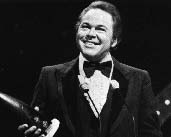 and
rousing country rockers. His brand of humor is infectious. He is difficult to categorize.
Is he a singer, a comedian or an instrumentalist? The answer is that he’s more than
all of these. He is a great entertainer. and
rousing country rockers. His brand of humor is infectious. He is difficult to categorize.
Is he a singer, a comedian or an instrumentalist? The answer is that he’s more than
all of these. He is a great entertainer.
He headlines his own show at the world’s leading venues from Carnegie Hall and
Madison Square Garden in New York City to the Rossiya Theater in Moscow. Roy is in
constant demand as a star attraction at the leading casinos, headlining shows at
Caesar’s Palace, Bally’s Grand Hotel and, for years, at the Frontier Hotel in
Las Vegas, along with Harrah’s in both Reno and Lake Tahoe and the Showboat in
Atlantic City.
Recognized as one of the top five major fair and rodeo attractions, he has headlined a
list of state fairs that includes nearly every one of the fifty states. Roy has been a
repeat star for multiple years at the famous Cheyenne Frontier Days Rodeo and the Houston
Rodeo.
Roy Clark has hosted America’s most popular weekly syndicated television show
“Hee Haw” for 20 years. “Hee Haw” is carried on over 200 television
stations and viewed by 30 million people weekly. He constantly appears as a guest on major
talk and variety shows. He was the first country music artist to guest host on Johnny
Carson’s “Tonight Show,” where he still appears as a frequent guest.
Roy’s talent for acting goes back to the mid-60's when he frequently appeared on
the popular “Beverly Hillbillies” television series and has brought him many
acting parts on both episodic television and in motion pictures. He recently co-starred
with Mel Tillis in a major motion picture release “Up Hill All The Way,” a
country western.
Last year Mr. Clark was inducted as a member of the Grand Ole Opry in Nashville.
Roy’s virtuosity is showcased by the variety of appearances he makes annually.
Besides his own concert appearances, he is featured regularly as a guest artist with many
of the top symphonies. One of his personal highlights was his featured performance with
Arthur Fiedler and the Boston Pops, which was seen as a special on PBS-TV and was one of
their most popular shows of the season.
He has hosted his own series of television specials including Country Music, U.S.A.
(HBO), Flying Down To Provo (ABC Network), Country Goes To Switzerland and Roy Clark In
The Bahamas (syndicated), three music specials for BBC TV and his own special broadcast
live throughout the Soviet Union during his concert appearance in Moscow.
Some of Roy’s major awards have included his being named Entertainer of the Year
by the Academy of Country Music and the Country Music Association, Comedy Act of the Year
by the Academy of Country Music, Country Music Star of the Year by the American Guild of
Variety Artists, Playboy Magazine’s Readers Poll as Picker of the Year, Best Country
Guitarist by Guitar Magazine, Country Music Banjo Championship an the list goes on and on.
Roy received a Grammy in 1982 for his instrumental performance of Alabama Jubilee.
Roy is an avid sportsman. Together with his wife Barbara they breed and race
thoroughbred horses. Their home is in Tulsa, Oklahoma, and their ranch is located in
northeast Oklahoma. A pilot for years, Roy flies his Mitsubishi Diamond 1A jet to most of
his engagements.
Roy Clark is truly one of the great entertainers in the world today. |
| Cecil
B. DeMille
His parents Henry Churchill and Beatrice DeMille wrote plays. Henry died when he was 12
and his mother supported the family by opening a school for girls and a theatrical
company. Too young to enlist in the Spanish-American War 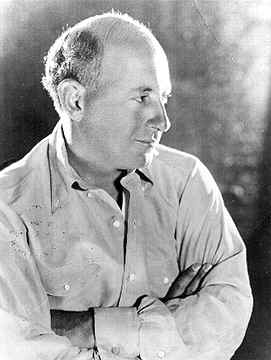 he fallowed his brother William to the New York
Academy of Dramatic Arts, making his stage debut in 1900. For twelve years he was
actor/manager of his mother's company. In 1913 he, Jesse L. Lasky and Sam Goldwyn formed
the Lasky (Paramount) film company and, the next year, produced the successful six reeler,
"The Squaw Man" their first Hollywood film. He championed the switch from short
to feature-length films and is often credited with making Hollywood the motion picture
capital of the world. Rather than putting his money into known stars he emphasized
production values. He also developed stars, notably Gloria Swanson. He produced and
directed 70 films and was involved in many more. Many of his films were romantic sexual
comedies (he is supposed to have believed that Americans were curious only about money and
sex). His best-known were biblical epics: King of Kings, The Ten Commandments, The (1923)
Crusades. From 1936 to 1945 he hosted and directed the hour-long "Lux Radio
Theatre", which brought the actors and stories of many movies to the airwaves and
further established him as the symbol of Hollywood. He appeared as himself in Sunset Blvd.
(1950) with his own long-ago star Gloria Swanson playing the has-been Norma Desmond. Return
to Last Page he fallowed his brother William to the New York
Academy of Dramatic Arts, making his stage debut in 1900. For twelve years he was
actor/manager of his mother's company. In 1913 he, Jesse L. Lasky and Sam Goldwyn formed
the Lasky (Paramount) film company and, the next year, produced the successful six reeler,
"The Squaw Man" their first Hollywood film. He championed the switch from short
to feature-length films and is often credited with making Hollywood the motion picture
capital of the world. Rather than putting his money into known stars he emphasized
production values. He also developed stars, notably Gloria Swanson. He produced and
directed 70 films and was involved in many more. Many of his films were romantic sexual
comedies (he is supposed to have believed that Americans were curious only about money and
sex). His best-known were biblical epics: King of Kings, The Ten Commandments, The (1923)
Crusades. From 1936 to 1945 he hosted and directed the hour-long "Lux Radio
Theatre", which brought the actors and stories of many movies to the airwaves and
further established him as the symbol of Hollywood. He appeared as himself in Sunset Blvd.
(1950) with his own long-ago star Gloria Swanson playing the has-been Norma Desmond. Return
to Last Page |
| Michael
Cain
Born into extreme poverty in South London to a working poor family, Maurice Micklewhite
has come a long way from 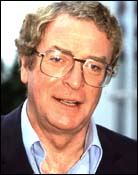 his humble beginnings. Acting was probably not the most sensible route to
take, and it must not have impressed his parents overly much, but in the end the decision
proved to be a good one. his humble beginnings. Acting was probably not the most sensible route to
take, and it must not have impressed his parents overly much, but in the end the decision
proved to be a good one.
Maurice Micklewhite then became Michael Caine, taking his new surname from his favorite
movie, The Caine Mutiny. In 1966, he came out of nowhere to land a starring role as Alfie,
a disgusting but highly memorable character (for which he won a Golden Globe), and as
agent Harry Palmer in a trilogy of spy films.
Caine was once known to be a heavy drinker and a reveler in excess. However, with age came
maturity. With his newfound steadiness, he managed to develop his craft and transform
himself into an even more impressive actor. He won critical praise and Oscar nominations
for his work in Alfie, Sleuth and Educating Rita, and won for Hannah and her Sisters. He
also won several Golden Globes and Emmys for his work in cinema and television.
Caine’s career languished a bit in the late 80s and early 90s, and his fame seemed on
the decline. Such films as Mr. Destiny and On Deadly Ground certainly didn’t help. An
attempt to resuscitate the Harry Palmer character was not quite successful either.
Recently, however, Michael Caine has mounted a comeback.
Using television as a spring board, he appeared in Mandela and De Klerk as the South
African leader, and in 20,000 Leagues Under the Sea as the famed Captain Nemo, both of
which re-introduced him to audiences.
Taking a role in the small independent film, Little Voice, has lead to even greater
things. The film was loved by critics and audiences, and Michael recently won another
Golden Globe for his portrayal of Ray Say. As he said in his acceptance speech, he’d
“made a lot of crap” , and “a lot of money”, so that now he had the
luxury to be able to sit back and choose the good roles. If his choice of Little Voice is
prophetic, then Caine should be just entering the prime of his career.
Return
to Last Page |
| Ernest
Borgnine
Borgnine was born to Italian parents on January 24, 1917, in Hamden, Connecticut. He
grew up in New Haven,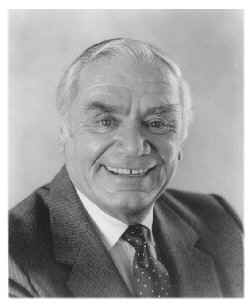 and after completing high school, entered the Navy. He
rose through the ranks, and left the service as a Chief Gunner's mate. He then enrolled in
the Randall School of Dramatic Arts in Hartford, after which he joined the Barter Theatre
in Virginia. and after completing high school, entered the Navy. He
rose through the ranks, and left the service as a Chief Gunner's mate. He then enrolled in
the Randall School of Dramatic Arts in Hartford, after which he joined the Barter Theatre
in Virginia.
Borgnine made his Broadway debut as the hospital attendant in "Harvey." From
there, he went on to character and lead roles in motion pictures, making his film debut in
1951 in "China Corsair." He was initially predominantly cast as the heavy, as
typified by his roles in "From Here to Eternity," and "Bad Day at Black
Rock." But that changed with "Marty." His performance as the lonely Bronx
butcher earned him an Academy Award as Best Actor, as well as top honors from the New York
Film Critics, the Cannes Film Festival, and the British Academy Award. Subsequent films
include "The Catered Affair," "Badlanders," "McHale's Navy,"
"The Wild Bunch," " The Poseidon Adventure," "Emperor of the
North," "Escape From New York," and the recently released
"Gattica." His live television roles include "G.E. Theatre" and
"Philco Playhouse."
In the sixties, Borgnine starred in the series "McHale's Navy." He later
played Dominic Santini on "Airwolf" from 1983-86, and Manny, the doorman, on
"The Single Guy" from 1995-1997. He also does the voice for the children's
series based on the animated feature "All Dogs Go To Heaven II."
Borgnine lives in Beverly Hills with his wife, Tova, who heads her own world-famous
cosmetics company. He plays golf, is active in many charities, and has been honored with
the 33rd Degree of the Masonic Order, and their order of the Grand Cross. He has received
three honorary doctorates, has been bestowed with the title Honorary Flight Leader for the
Blue Angels, and has been honored for his support of the Navy Memorial Fund with the
"Lone Sailor" award from the Memorial Foundation.
The San Luis Obispo International Film Festival is privileged to present its annual
lifetime achievement award to this highly talented, and greatly beloved gentleman. In
addition to the screening of "The Catered Affair" at his Tribute, we are also
presenting during the Festival "Bad Day at Black Rock," "Marty," and
"The Wild Bunch." Return
to Last Page |
| Gene
Autry
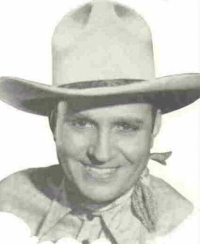
Autry succeeded at just about anything he undertook: radio, records, songwriting,
movies, TV, real estate and business.
He first sang on the radio in 1928, and then went on to make a whopping 95 films and star
in a TV show from 1950 to 1956. He also cut 635 records, including "Rudolph the
Red-Nosed Reindeer" and his signature "Back in the Saddle Again."
Autry, who had homes in Studio City and Palm Springs, hung up his performing spurs in
1956, but continued to own four radio stations, the Gene Autry Hotel in Palm Springs, and
several other properties, said the wire service. In 1982, he sold Los Angeles television
station KTLA for $245 million.
Autry ranked for many years on the Forbes magazine list of the 400 richest Americans.
However, in 1995 he fell to the magazine's "near miss" category with an
estimated net worth of $320 million, said AP.
Autry, who once turned down a chance to play in the minor leagues, owned the California
Angels baseball team from 1961 to 1995, said AP.
In spring 1995, Autry announced that the Walt Disney Co. was buying a part interest in the
team. The following year Disney took operating control, changing the team's name to the
Anaheim Angels. Disney had an agreement to acquire Autry's remaining share of the team at
his death.
Throughout his business dealings, Autry collected Western memorabilia and art, said AP. In
December 1988, the Gene Autry Western Heritage Museum, built largely with funds from
Autry's foundations, opened in Los Angeles' Griffith Park.
"I felt that I owed something. The West has been very kind to me over the
years," Autry said at the time.
He called the museum, which covers the West from prehistoric times to Hollywood, a gift to
the world rather than a monument to himself, said AP. Among the items in the $54 million
museum are an 1870s-era steam fire engine from Nevada, guns owned by Annie Oakley and
Wyatt Earp, and costumes of TV's Lone Ranger and Tonto.
He first came to Los Angeles in 1934 to appear with Ken Maynard in a movie called
"Old Santa Fe," said AP.
"I was the first singing cowboy in that picture," Autry once said. "John
Wayne had made an earlier movie in which he played a singing cowboy, but he didn't do his
own singing."
Autry was ranked top Western star at the box office from 1937-43, and in 1940-42 he was in
the Top 10 of all movie box office favorites, said AP. Smiley Burnett was popular as
Autry's comic sidekick, and Autry's horse, Champion, also was an audience favorite.
Roy Rogers replaced Autry as Republic Studios' top cowboy when Autry took time out to
serve as a flier in the Army Air Corps during World War II. After the war, he went over to
Columbia Pictures and obtained a new partner -- Pat Buttram.
Among his postwar pictures were "The Last Roundup," 1947, and "Riders in
the Sky," 1949.
When Rogers died last July, Autry called it "a terrible loss for me. I had tremendous
respect for Roy and considered him a great humanitarian and an outstanding American,"
reported AP.
Autry's broadcasting career included appearances on the "Melody Ranch" CBS radio
show, beginning in 1939. From 1950-56, he was host of "The Gene Autry Show" on
CBS-TV, one of the first television series made by a motion picture star, said AP.
Autry was born Sept. 29, 1907, in Tioga, Texas, and grew up in the small Oklahoma town of
Ravia.
As a boy, Autry occasionally earned spending money singing at local nightspots, said AP.
It's with this money that he bought a mail order guitar and taught himself how to play.
Autry began singing on radio shows in 1928 as "Oklahoma's Yodeling Cowboy." In
the early '30s, he was a success on the popular "WLS Barn Dance" in Chicago.
Autry stopped appearing in the movies and on television in the mid-1950s to concentrate on
his businesses.
Return
to Last Page |
Return To Home Page
|
